|
| Book Transcription |
Copyright, 1930, by Horace Liveright, Inc.
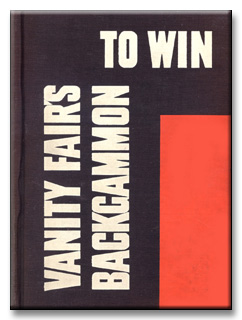
|

|


Gratefully dedicated
to
Roy A. Rainey
and
George B. Post, Jr.
G. M.

Foreword
A strange and somewhat inexplicable thing has recently happened: a very ancient game, a game which for many years the uninitiated public considered nothing but “child’s play,” mysteriously and suddenly emerged from the inside of the nursery checkerboard and, taking possession of the adult imagination, swept over the entire country. The ancient game of Backgammon had, over night, become a national craze.
But this new craze, it was discovered, seemed to have more to recommend it than the fact that it had become the pastime of fashionable people everywhere in America. Backgammon had a background. Its lineage was an ancient and honorable one. At any rate this was the belated discovery of the new writers on the game, as they rushed to their Encyclopedias and Hoyles, pointing with pride and fulsome awe to the fact that Backgammon had been played in Ur of the Chaldees, and that it was a favorite diversion of Tutankhamen himself, who — (and many a modern devotee of the game threatens to emulate him) — insisted on having his board buried beside him in his tomb.
Backgammon was known to the Greeks and Romans of ancient times, to Chaucer, Shakespeare and Dryden. Indeed, so great has been the zeal of the historians to prove its noble pedigree, that they almost succeeded in convincing their interested readers that it was the fireside pastime of Cro-Magnon man. The philologists capped the historians’ ludus duodecim scriptorum, or tabulae: (the ancient Roman name for the game) with a neat, but somewhat lengthy discourse as to whether the derivation of the word Backgammon was from the Welsh, bach, meaning little, and cammaun meaning battle, or the Saxon bac, meaning back, and gamen, meaning game.
But when the smoke of these piquant controversies had blown away, one fact emerged triumphant: Backgammon was a fascinating game. Of course, this was no news to the clubmen and oldsters who had been quietly playing it — to their intense satisfaction — for years. They had known it all along. ... They had not known, however, that what Backgammon needed to make it acceptable to the public was an element of danger and daring, a kaleidoscopic quality without which no modern game can succeed. This element, it must be quickly stated, was provided by the Double, a new and inspired development in Backgammon. It is the Double which has lifted Backgammon from the dry plains of strategy and science to the adventurous and romantic heights of an exciting gambling game, a game which is peculiarly suited to the modern scene and temperament.
The uniqueness of Backgammon as it is now played rests in the paradox that, while it has become a gambling game, it still remains essentially a game of skill, rather than luck, a game in which all the profits go to the experienced, rather than the reckless player, to the player who will gamble with his luck, but never against his percentages. In other words to the player who takes chances, but who knows exactly what chances he is taking. And in this knowledge lies the secret of successful Backgammon, and also the raison d’étre of this book.
The Editors of Vanity Fair were among the first to give Backgammon editorial attention by publishing papers by the best writers on the game. It soon developed, however, that while many of these articles had been excellent, they could not cover the entire strategy of this popular game, nor could they prevent players from falling into various misapprehensions, errors and confusions which were the inevitable result of the naturally limited scope of monthly articles. Therefore, Vanity Fair determined to publish an authoritative volume on Backgammon which would give the reader a sound and clear idea of its strategy.
Georges Mabardi, the author of this book, is acknowledged — by both the most experienced players and authorities — to be one of the finest exponents of the game, and one of the most successful players, in America today. It might be even said that he “inherited” his skill, for he is an Egyptian by birth and in Egypt Backgammon has been played for thirty centuries. It is a national diversion there now. Mabardi himself has played it, studied it and taught it since he was a child. Surely of all the Backgammon authorities, none is more fit to expound the sadly neglected, fundamental and traditional principles of the game.
The beginner will save himself much bitter experience by a careful application of the theories contained in this book. The advanced player will, by pondering Mr. Mabardi’s theories and strategies, find ways to increase his pleasure in it and — if he prefers to play Backgammon for profit rather than for pleasure — a means of increasing his winnings.
— The Editors of “Vanity Fair”

Part I
For the Beginner

Chapter I. Mechanics of Play
a. The Set-up
The game of Backgammon is played on a board which is divided into two halves, or tables, “by a perpendicular wall called the bar. Extending from the sides nearest the players and pointing” towards the center of the board are thin triangles, or points, alternately colored. There are twelve points on each side. Each player uses fifteen markers, or men; usually white for one player, and black for the other. And each player is equipped with a cup and a pair of dice.
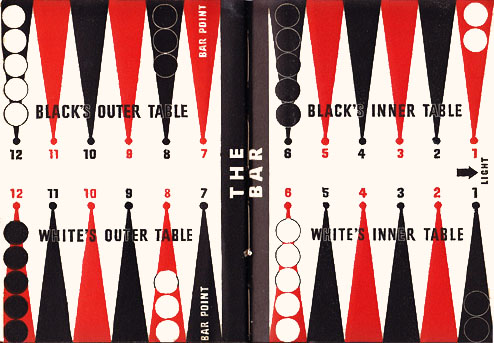
A player’s men are set up on the board as illustrated in the Opening Diagram: two men on his opponent’s one-point, five on his opponent’s twelve-point, three on the player’s eight-point, and five on the player’s six-point, making a total of fifteen. The opponent’s men are set up conversely. The outmost men, the twin groups of two opposite each other on the one-points, are said to be in the table “towards the light,” and when possible should always be set up that way.
The tables nearest the light are called the inner tables, that part which is directly in front of the player being his inner table, the part opposite him being his opponent’s. The direction of play for a player is always towards his own inner table; the opponent’s direction always being in the opposite. These directions never change. (See Diagram 2.)
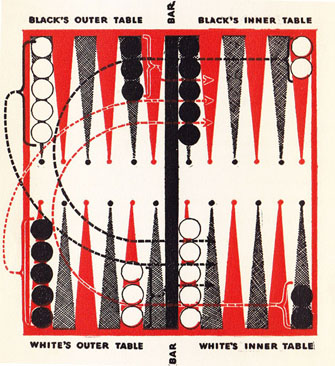
Diagram 2
Direction of Play
When the game starts, if there is any dispute as to which side of the board shall he occupied by a certain player, or which end of the board shall he called towards the light, and the men set up accordingly, a single die is cast by each player, and the one who throws the highest number has the choice.
By turning the opening diagram upside down, and reversing the color of the men, the beginner may see how the board would look set up with the inner tables towards a light on the left, instead of the right.
It is sometimes difficult for the beginner, unaccustomed to the board and the moves, to play rapidly. But he should master the distances between points at once; until he can play quickly he will have a hard time inducing good players to bother with him. In learning to speed the pace of his play, he should note that moves may thus be calculated easily:
1. A diagonal move from one corner of a table to another is always six points; 2. from one end of a table to the other, five; 3. from one corner of the board diagonally to the other, twelve; 4. from one end of the board to the other, eleven; 5. from one corner of a table diagonally to the corner of the other table, seven; and, 6. an even number carries a man from a triangle of one color to a triangle of the same color, whereas an uneven number carries a man from one color to the other color.
b. The Start
When the positions have been decided and the men set up, each player throws a die into the table at his right — all his throws during the entire game must be made in this table. The player throwing the highest die wins the right to start the game and immediately makes the first move, using the combined numbers of his and his opponent’s die, which have just been cast. If on this first throw, the pips on both dice are the same — that is to say, a doublet results — the throw must be made again; if doublets once more come up, the throw is again made, and so on until the numbers of the dice are different. The first time they are different, the player throwing the highest number begins the game.
c. Playing the Throws
A play is made in Backgammon by moving a man, or men, as many points as there are pips on the thrown dice. For instance, if Black throws a six, and White a four, on the opening shake, Black may move one of his men six points and the other four, or he may move one man ten points. His play is then completed. White, in turn, then throws both of his own dice and moves his men accordingly. This alternate procedure continues until the game is ended. It is only on the first shake that each player throws one die, when the total of the two is played by the player throwing the higher.
If, after the first throw, a player casts doublets — such as two fours, two fives, etc. — he moves a man, or men, twice the number of points indicated. For instance, if White throws double-sixes, he plays four sixes instead of two, and so on. All other throws, save doublets, are played for the number of points corresponding exactly to the numbers on the dice cast.
In playing a throw, the number on each die is played separately, never the total as a single number. If a player throws six-four, he must play a six and then a four, or vice versa; he can play both numbers with one man, but the numbers must be played separately. In moving, the point on which a man is resting is not counted, but the point to which the man is being moved is counted. Thus, a man is always moved to a point one triangle farther away from the starting triangle than the number on the die indicates. For example, a man is moved four points to the fifth point away, five points to the sixth, and so on.
In moving his men around the board towards the final destination — his own inner table — a player is governed by several specific rules. To begin with, he cannot move a man to a point on which two or more of the opponent’s men are resting; a point so occupied by an opponent is called “made” or “held.” As the number on each die must be played separately, a player cannot move a man to a free point if intervening points, to which he must move in the process, are occupied by two or more of the opponent’s men.
For instance, if Black throws six-five and wishes to move to a free point eleven triangles away, he cannot do so if both the points six and five triangles away, respectively, are occupied by two or more of the opponent’s men; but if either of them is free, he may make the move. In other words, the player must always bear in mind that he is making his move not with the total of the two dice cast, but first with the number on one die, and then with the number on the other. Of course, a player may always move to a point “held,” or occupied by two or more of his own men.
At all times during the course of a game the numbers on both dice must be played whenever this is possible. If either, but only one, of the numbers can be played, the higher must be the one. For example, if the player has a six-four to play but, on account of points occupied by two or more of the opponent’s men, cannot play the full number of ten, but can play either the six or the four alone, he must always play the six.
d. Taking Up
If a player — and frequently he will try to do this — moves to a point occupied by only one of his opponent’s men, that man is called “hit” or “taken up” and must be placed out of play, on the bar. To get back into play, the opponent’s man on the bar must be reentered in the player’s inner table; in other words, he is sent back to start his journey home all over again.
The method of re-entering is as follows: The points in each inner table are numbered away from the light (according to convention, although this is not indicated on the board) the one-, two-, three-, four-, five-, and six-point. The man which has been taken up and set on the bar can re-enter on any one of the six points in his opponent’s inner table which are not occupied by two or more of the opponent’s men when the player throws a corresponding number with the dice.
For example, if a player has a man on the bar and none of the points in the opponent’s inner table is occupied by two or more opponent’s men, save the six-point, he can re-enter his man on the one-point if he throws a one with either die, on the three-point if he throws a three, on the four-point if he throws a four, on the five-point if he throws a five, but not on the six-point, even if the dice show a six. The same rule which prevents a player from moving a man to a point occupied by two or more of the opponent’s men prevents him from entering a man on a point in the opponent’s inner table which is similarly occupied. If all the points in the opponent’s inner table are occupied, each by two or more of the opponent’s men, as sometimes occurs in the later stages of the game, a player cannot enter a man from the bar, no matter what he throws. He can at all times, of course, enter a man on a point occupied by one or more of his own men.
While one or more of the player’s men are on the bar, he cannot play any other man; and must remain idle while his opponent throws and moves. After the opponent has completed his move, the player who has a man on the bar shakes again in turn and tries once again to enter; should he again be unsuccessful, he once more must remain idle while the opponent throws, and so on. When the player finally throws a die which allows him to enter his man, he may play the number on the other die with any of his other men, or with the newly entered man. But if the player has more than one man on the bar, he must enter them all before moving any other man on the board.
If a man is entered from the bar on a point that is occupied by one opponent man, that man, obviously, is hit or taken up, and is placed on the bar from whence, in turn, the opponent must enter him on the player’s inner table.
A single man on a point is called a “blot.”
e. Object of the Game
The object of the game is for the player to move all his men around the board and into his inner table, at the same time impeding the progress of his opponent as much as possible in attaining a corresponding objective. Once the player has brought all his men into his inner table, he begins the final operation of the game, which is known as “bearing off.” This consists of removing men from the inner table and off the board according to the throws of the dice. The first player to do this wins the game.
f. Bearing Off
In bearing off, the player removes from his inner table men resting on the points corresponding with the numbers thrown on the dice. Thus, if a five-four is cast, the player removes one man from his five-point and one from his four-point, and stacks them outside the board; if his next throw is a six-five, he removes one man from his six-point and one man from his five-point, and so on. If doublets are cast, four men of the number thrown are removed.
But it will frequently happen that the player will throw a number which bids him remove a man from a point on which he has no markers. When this occurs, one of two things must be done: if all the points higher than the point indicated by the dice are also vacant, a man or men, as the case may be, are borne off from the next lowest point; but if there are one or more occupied points higher than the point indicated by the number thrown, men from these points must be moved up towards the one-point for the number of moves called for by the cast.
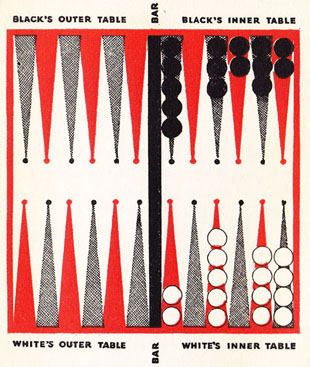
Diagram 3
Bearing Off
To illustrate: Suppose that White’s men are lined up as in Diagram 3, and the bearing off is about to begin. If White throws six-four, he removes one man from the six-point and one man from the four-point. If he throws six-five, he removes one man from the six-point but is unable to play the five off as the five-point is unoccupied; therefore he moves the remaining man on the six-point to the one-point, a distance of five points. This is called “playing up.” If White, in the original position, shakes five-three, he must play two men up, as both the five- and three-points are empty. The best way to do this would be to play one man from the six-point to the one-point, and one man from the six-point to the three-point, thus covering the latter point in case a three is shaken on the next throw. If White, from the original position, shakes any doubles — double-fours or double-ones for instance, he bears off four men from the four-point or four men from the one-point, as the case may be.
But let us suppose that the two men on the six-point have already been removed when White shakes a five-four; in this case he plays the five from the four-point, because there are no higher points occupied by his men, and the four from the four-point, as usual. If he should throw a six, he would play it, too, from the four-point for the same reason, and when all the men from the four-point are gone, the two-point, being the highest of the occupied points remaining, will be played for every number from six to two, inclusive. If White’s first throw is double-sixes, he will bear off two sixes and then two fours, since, after the sixes have all been removed, the four-point becomes the highest and therefore is played for every number of four or higher.
If the player finishes bearing off his men before the opponent, the player wins a single game. If the player bears off all his men before the opponent bears off any, the player wins a gammon, or double game. If the player bears off all his men before the opponent bears off any and the opponent also has one or more men in the player’s inner table, the player wins a backgammon, or triple game.
g. The Double
After the game has started, either player, before he throws his dice, may double the stake for which the game is being played by merely announcing to his opponent that he wishes to do so. The opponent must accept the double and play for the increased stake, or he must resign and pay the original stake.
After the first double, only the player who has accepted it may double again, thereby increasing the original stake four-fold. If he does so, the opponent must accept or resign and pay two stakes — the original and the one he added himself by his first double. Should he accept, the game continues for four stakes and the accepter of the last double is then privileged to double again. There is no limit to the number of doubles that may thus be alternately made.
Most players employ what is called an automatic double: if the throw for the first play, when each player casts a die, results in a doublet, the stake is automatically doubled; if the second throw brings a second doublet, the stakes are again doubled, and so on. This practice is often objectionable because it arbitrarily forces play for higher stakes, giving the players no chance for resignation.

Chapter II. General Strategy
The best way to learn the game of Backgammon is to master the rules and regulations as set forth in this chapter and then play as much as possible with experienced players. After he has had some practice in actual play the beginner should memorize the correct opening moves as given in Chapter II, Part II. When he has used them in so many games that they become second nature, the player can then devote himself to a mastery of the finer points of strategy as described in Part II. From that point on, his proficiency at the game will depend entirely on how much time he is willing to devote to its study, and the amount of good play in which he is able to participate.
The pace of Backgammon is so fast, the change in position of such lightning rapidity, the possible combinations so multitudinous, that exact rules of procedure are impossible to evolve. After the beginner is told exactly how to play the openings, there is little more in the way of hard and fast rules that can be set before him. There are, however, certain general advice and admonitions which may be of use to the beginner.
a. Cardinal Principles
First, the novice should remember that Backgammon is always a game of retreat, never of advance. If it seems strange that victory can be won by retreating, remember that many great battles have been won that way. In Backgammon the player is always trying to withdraw his men from their original positions in enemy territory to the final position of safety in his own inner table, at the same time trying to block, impede and delay the similar retreat of the enemy forces.
Secondly, the novice should never forget the two cardinal principles of the game: 1. Bring your outmost men nearer home at every logical opportunity, and, 2. Never take unnecessary risks. If the beginner will always practice these two rules, he will be a long way on the road to success. The outmost men — the two on the opponent’s one-point — are your weakest units, for they are farthest away from your base; therefore, rescue them as soon as you can, withdrawing them carefully from one prepared position to another until they can be placed in safety. And as for taking risks, let your opponent do that, and profit by his mistakes; play cautiously and conservatively yourself, for in the long run, the sound and conservative player always wins.
b. Inner Table Blots
Never take up a blot in your inner table, (a) unless you can cover your man by making a point, or, (b) unless there is no other play open to you. Remember that your five men in your inner table represent an already accomplished retreat from the opponent’s inner table (the theoretical starting point of all men) and are therefore much more valuable than men farther out, and accordingly, should be played much more carefully.
c. Making Points
Next in importance to withdrawing your two outmost men at the earliest opportunity, is the advisability of making the following points listed here in the exact order of their importance: 1. — Player’s five-point, 2. — Opponent’s five-point, 3. — Player’s bar-point, and 4. — Opponent’s bar-point. The bar-point is the triangle just outside the bar from the inner table, the seven-point. In making his own five-point, the player impedes the progress of the opponent’s outmost men on the one-point (stopping them from running on double-fours) and secures a point in his own board that will help make the opponent’s reentry more difficult if he is taken up.
By making the opponent’s five-point, the player withdraws his outmost men an appreciable distance, makes their further retreat easier, and commands the opponent’s outer table from this point of vantage. By making his own bar-point, the player blocks the escape of the opponent’s outmost men on double-sixes and secures another prepared position to which he can safely retreat his home-coming markers. And by making the opponent’s bar-point, the player withdraws his outmost men a good distance, prevents the opponent from capturing the same valuable point, and again commands the outer table. The making of as many of these four salient points as soon as possible should always be the primary objective of any player’s early game.
In this connection, the following throws are valuable in the early game, for the following reasons:
Double-ones, because they make the player’s bar- and five-points.
Double-sixes, because they make the player’s and opponent’s bar-points.
Double-fours, because they make the player’s nine-point and opponent’s five-point.
Three-one, because it makes the player’s five-point.
Double-twos, because they make the opponent’s five-point.
Six-one, because it makes the player’s bar-point.
Double-threes, because they make the player’s five-point and the opponent’s four-point.
d. The Closed Board
Another operation the beginner should learn to complete is the one called “closing the board.” This means a continued erecting of points in the player’s inner table which will result, finally, in there being two or more of the player’s men on each of the six inner table points. When this manoeuver has been completed, any of the opponent’s men which have been hit are unable to re-enter the game from the bar and must therefore rest idle until the player is ready to, or is forced to, open his board by moving forward men from one point to another.
When a player has a man on the bar and his adversary has a closed board, that player does not even throw the dice in turn, as it is useless, there being no throw which will allow him to re-enter. The adversary with the closed board throws his dice uninterruptedly until he has brought in all his men and is ready to commence bearing off, or must of necessity open up his board because he has no other possible play. In the meantime, the owner of the man on the bar can only sit back and hope that his adversary will eventually make an unlucky throw.
e. Position
The most important idea of Backgammon for the beginner is to keep in mind the idea of position. The adept player is the one who at all times knows exactly how far he is ahead of his opponent, or how far his opponent is ahead of him. To become even moderately proficient at the game, you must learn to judge often and accurately the comparative strength of the opposing men, for, if you are definitely behind and your opponent doubles, you will want to resign; whereas on the other hand, if you are definitely ahead, you will want to double. If you do not know how you stand, you can never hope to know when to double, when to accept a double, or when to resign in the face of one.
f. Tactics
The definite tactics of the game, will he found described in Part II, Chapter III, but the beginner need not bother too much about them until he has had plenty of playing experience and has developed a clear idea of the purpose of the game. The science of doubling is dealt with in Part II, Chapter VI, and should be studied as soon as actual play is commenced. Bearing off, Part II, Chapter V, can also be best understood when this study is completed, as should the chapter of general strategy in Part II.
But remember, especially if you find the explanations of tactics and strategy in Part II of this hook too technical and confusing, that they only become simple after long play. And remember, finally, that the best way to learn Backgammon is to play it unceasingly with superior players.

Part II
For the Experienced Player

Chapter I. “Modern” Backgammon
This chapter is made necessary by the varied attacks, under one guise or another, which have been directed at Backgammon ever since its return to well-deserved popularity. This is, however, by no means an apology. It is, rather, a restating of certain fundamental principles which the present-day enthusiasts have overlooked, for one reason or another, in their haste to popularize the game by the use of startling but doubtful theories. To see Backgammon suddenly become popular is a joy to every old player; but to see novices rush in — blindly where he has fearsomely trod for many long years, arouses the seasoned player’s immediate protest.
Some self-appointed “new authorities” have seen fit to evolve a strange hybrid which they call “modern” Backgammon. There is no such thing — unless “modern” Backgammon is another name for bad Backgammon. A game which has not changed in centuries cannot be altered overnight simply because more people are now playing it than ever before. The principles, the conventional moves, strategy and tactics, are the same today as they were in Chaucer’s time, no matter how many fresh enthusiasts rush into print with books heralding “the new game.”
Doubtless the Twentieth Century passion for “modernizing” is responsible for this ill-advised attack on an ageless game. The effort is as futile as trying to touch up the Mona Lisa so that it may be attributed to the Post-Impressionists. Backgammon is an elemental game; and because of its very simplicity it cannot change.
The cause of the present confusion about the so-called “modern” Backgammon is, specifically, the recent development of two minor conventions — The Double, and Chouette. The former, however, is merely a new way of scoring; and the latter is simply an improvisation which allows interested bystanders to wager on the outcome of the game and still retain an interest in the stakes the while they are not playing. True, the Double frequently forces a player to resign a game before its completion; but that has been happening, in the beaten player’s own mind, for thousands of years. And certainly the side-bet, the primary idea of Chouette, is nothing new. It is therefore obvious that neither development in any way affects the fundamental principles of the game.
Since these two new conventions — and admirable ones they are — represent the only changes in Backgammon from the beginnings of its history, and since they do not alter the basic game in any degree, the student may be pardoned a certain confusion when he is bombarded on all sides with books which claim to propound the theories of a “new” Backgammon, based on the false premise that the game has radically changed. It follows that, as the game has not changed, any new system of play presumes to disregard the sound strategies which have endured for centuries.
Clearly to understand the fundamental principles of the game, before studying its less important technicalities, let the reader visualize an army in the field, its intrenched line reaching from a strong base to an extended outpost in enemy territory; in a word, a salient. The commander of this army wishes to withdraw his men from the position to the final safety of his base with as few casualties as possible. What is the soundest general strategy?
Obviously, if no units are to be lost, the tip of the salient must be withdrawn first, then the sides, and finally the center. For, if the men nearest the base are withdrawn first, the units at the outpost will be left in danger of capture. Accordingly, the wise commander begins his retreat with his most exposed men, i.e., the outposts. That is the primary principle of his operation — let the farthermost advanced retreat to prepared positions, consolidate, retreat farther to other prepared positions, consolidate, again retreat, and so on until the base has been safely occupied.
The fundamental strategy of Backgammon is identical with this manoeuver. The two men on the opponent’s one-point represent the tip of the army commander’s salient. The first and most important principle of Backgammon is to bring these two outmost men safely home. If the player never learns anything more about Backgammon tactics, he should learn this. It will save him many a bitter defeat and win him many a victory.
Remember, too, that Backgammon is a game of continual retreat; that there is never an advance. Following the example of the army commander, the Backgammon player must continue the careful withdrawal of his outmost men to prepared positions — the opponent’s twelve-point, the player’s eight-point, and other strongholds incidentally arranged, until his base, the inner table, is safely occupied. While carrying out this concentration of forces, the player will be operating under fire of the enemy. Therefore he should always bear in mind the second great principle of the game, which is: Never expose a man to capture unless the risk (a) forces opponent to still greater risk when he takes advantage of it, (b) will result in an important gain if successful, or (c) is the lesser of two evils dictated by the dice.
If the player will obey these two fundamental principles of Backgammon and play the openings correctly he will be securely started on the difficult road to complete mastery of the game. There is no gainsaying that the road to perfection is difficult; success in Backgammon, despite appearances, despite the defeatist attitude of unseasoned enthusiasts, depends fifty per cent on skill. Countless potentially good players have been ruined by a belief that, because its equipment includes dice, Backgammon is entirely a game of luck. Remember that the dice merely indicate the length of each move; the player’s skill determines the manner. And it is the mode of play, as illustrated in this book, which wins games no matter how the dice may happen to fall.
As for the weird play of the “new” Backgammoners with its disregard for the fundamental principles of the game, and its false premise that the game has changed, let us examine its two outstanding characteristics. They are: First, reckless play. And, second, undue faith in the backward game.
1. Reckless Play. The most typical move of the “modern” enthusiast is an unorthodox eight opening, thus: one man from the opponent’s twelve-point to the player’s five-point. The defenders of this amazing move declare that in this manner a poor initial throw can he used to pave the way for making the player’s valuable five-point; and they add that, even if the blot is taken up, the opponent’s, inner table is open and re-entry therefore easy. All of which seems, at first glance, to be true. But — and this is the vital point — their argument completely disregards the two fundamental principles of the game: retreat the outmost men at every logical opportunity, and, do not take unnecessary risks. The player’s five-point is valuable, but not valuable enough to make the extreme risk worthwhile. Re-entry is easy, but after you have re-entered consider your position! The chances are 3-to-4 that the blot, which is already retreated 19 points, will be hit by a man that has not yet started to retreat. In other words, the player of this move is ready to sacrifice or retreat what is equivalent to the entire play of a shake of double-fours, in the hope that he will cover his five-point next time. This is a typical illustration of the false reasoning of those who seem to have forgotten the age-old strategies of the game of Backgammon.
2. The Backward Game. This strategy, almost as old as Backgammon itself, has lately amid much excitement been “discovered” by the innovators. It is only natural that they have come to seize upon it so tenaciously, because the reckless openings which are the hallmarks of their game put them so regularly at a disadvantage in the play that they needs must have recourse to this tactic as the only way out. Thus, from being forced continually to play the backward game, these new exponents of Backgammon have found in it engaging qualities and potencies which seemed to have escaped the discerning eyes of shrewd players for a thousand years.
The backward game is, to define it simply, the last recourse of the player who is at a disadvantage: with helpful dice, carefully manipulated against a weaker opponent, this strategy is frequently successful. Nevertheless, the backward game is primarily a defensive tactic, and cannot, by any stretch of imagination, be made into the brilliant offensive operation that the “modernists” would have it. An experienced player, ahead at the time, can almost always defeat a backward game with a sound position game.
But perhaps the most astounding innovation expounded by the unsound theorists of the “new” game, is the omission in play of the backgammon itself. The ultimate purpose of the player has always been to win a triple game, a backgammon; the name of the game itself comes from this aim. The only possible excuse for the omission lies in the weakness of the “new” game, which resides in the risky opening plays resulting in a constant use of the backward game. A constant use of the backward game results frequently in the loss of double games or gammons and, if the game were properly played, backgammons. Hence the rebels shrewdly omit the backgammon to spare themselves the losses their system of play deserves.
Chapter II. The Opening Moves
The Backgammon player’s initial moves mark him plainly as a tyro or an expert. The first play of the game depends entirely on the player’s own choice and ability; the men are set up by law; there is no difference in position; the start is equal. Whatever the dice throw may he, the Backgammon player will expose his ignorance of, or familiarity with, the game by the manner in which he makes his openings.
There are just three ways of playing each of the twenty-one possible opening throws — two wrong ways and the right way. First, there is the too conservative, and therefore futile, move of the novice. Second, the too risky, and therefore dangerous, play of the “modern” Backgammon enthusiast. And third, there is the correct opening, as played, from time immemorial, by masters of the game.
An opening move in Backgammon is determined by simple mathematical calculation and the indisputable judgment of long practice. The element of chance does not enter. As the starting positions of both players are identical, there can be but one correct initial move.
In the diagrams and explanations which follow, the correct opening is given for each of the twenty-one possible dice combinations. The incorrect openings are also discussed in order that there may remain no doubt in the reader’s mind as to their false value.
The following diagrams present the correct openings. They should be memorized by beginner and expert alike. If the reasons behind some of them are not at first clear, they will undoubtedly become so after long play and practice.
Double-Sixes
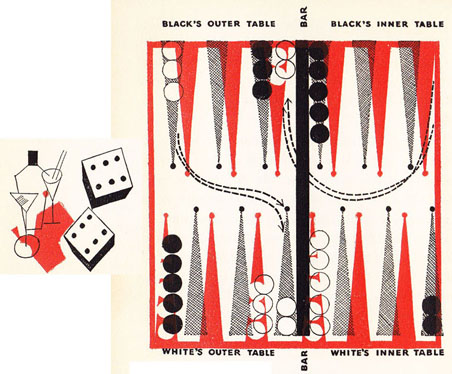
Two men from the opponent’s one-point to the opponent’s bar-point, and two men from the opponent’s twelve-point to the player’s bar-point.
The value of this opening throw is always overrated. It does afford a fine start for the running game; but, by its very uniqueness, often leads to final disaster. Many players double at once when opening with sixes. This is absolutely unjustified; a double should always be accepted with alacrity. The advantages of playing double-sixes correctly are obvious; both bar-points are secured and the outmost men are well started on the retreat.
Incorrect Plays
1. Three men from the opponent’s twelve-point to the player’s bar-point, and one man from the opponent’s one-point to the opponent’s bar-point.
2. Four men from the opponent’s twelve-point to the player’s bar-point.
These two freak openings do not secure the opponent’s important bar-point, or bring the two outmost men toward home as quickly as possible.
Double-Fives
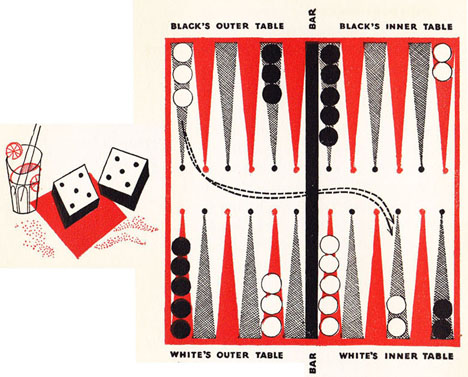
Two men from the opponent’s twelve-point to the player’s three-point.
One of the worst opening throws. There is no other way to play it.
Double-Fours
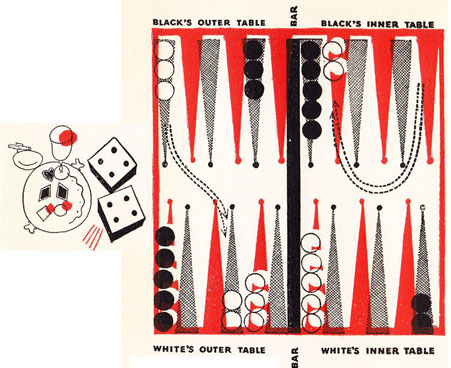
Two men from the opponent’s one-point t0 the 0pponent’s five-point, and two men from the opponent’s twelve-point to the player’s nine-point.
Next to double-ones, the best opening throw on the dice. Two of the fours allow the player to retreat his important outmost men to the opponent’s strategic five-point; the other two secure his own nine-point — a valuable building position.
Incorrect Plays
1. Two men from the opponent’s twelve-point to the player’s five-point. This play does not retreat the two outmost men as quickly as possible.
2. Two men from the opponent’s one-point to the opponent’s nine-point. While it does retreat the two outmost men farther than the correct play, this opening does not offer as speedy a trip home.
3. Any play that includes the making of the player’s two-point, because it definitely puts two men out of play. In the early game no point lower than the player’s four-point should ever be made — save with a five-three opening.
Double-Threes
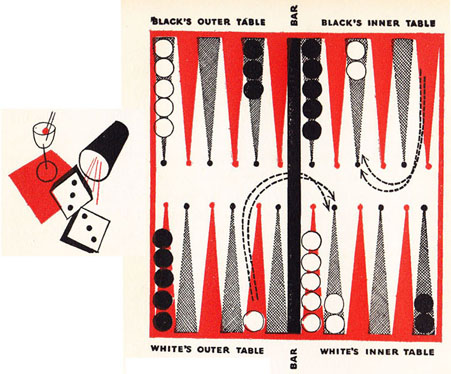
Two men from the opponent’s one-point to the opponent’s four-point, and two men from the player’s eight-point to the player’s five-point.
A good opening, retreating as it does the outmost men to a strategic position in the opponent’s inner table, as well as securing the player’s five-point. A blot is left, but the chances against being hit are 5-to-1.
Incorrect Plays
1. Two men from the opponent’s twelve-point to the player’s bar-point. This play always attracts the novice; but it fails to retreat the utmost men and fails to make the player’s five-point.
2. Two men from the player’s eight-point to the player’s five-point, and two men from the player’s six-point to the player’s three-point. While making the player’s valuable five-point, this opening again fails to retreat the outmost men and, further, puts the two men on the player’s three-point out of play.
3. Four men from the opponent’s twelve-point to the player’s ten-point. Outmost men not brought up; the player’s five-point not secured.
Double-Twos
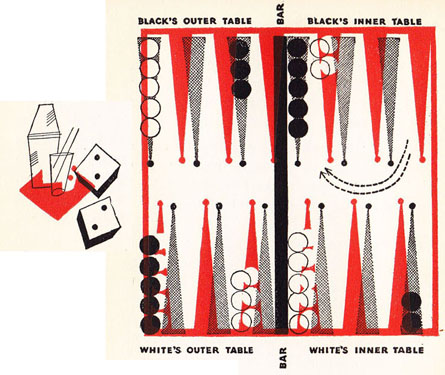
Two men from the opponent’s one-point to the opponent’s five-point.
An excellent opening, securing the opponent’s five-point and retreating the outmost men effectively.
Incorrect Plays
1. Two men from the opponent’s twelve-point to the player’s eleven-point, and two men from the player’s six-point to the player’s four-point. Outmost men not retreated; no important point made.
2. Two men from the player’s eight-point to the player’s four-point. The same fault as in the first incorrect play.
3. Two men from the player’s six-point to the player’s four-point, and two men from the opponent’s one-point to the opponent’s three-point. A half-hearted compromise. Ruthlessness and assurance win Backgammon games; temporizing loses them.
Double-Ones
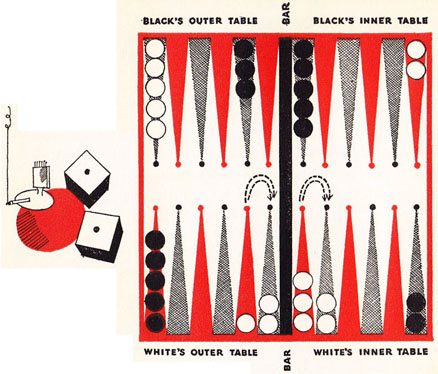
Two men from the player’s eight-point to the player’s bar-point, and two men from the player’s six-point to the player’s five-point.
The best opening throw. So far, even the most eccentric Backgammon teacher has been unable to devise an incorrect play for this combination.
Six-Five
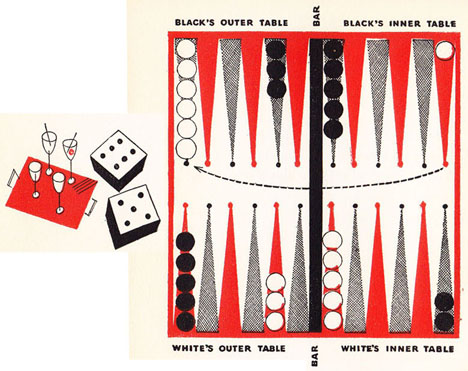
One man from the opponent’s one-point to the opponent’s twelve-point. A sturdy throw that brings one of the outmost men within skipping distance of home.
Incorrect Plays
1. One man from the opponent’s one-point to the opponent’s bar-point, and one man from the opponent’s twelve-point to the player’s eight-point.
2. One man from the opponent’s twelve-point to the player’s bar-point, and one man from the opponent’s twelve-point to the player’s eight-point. These two openings, aside from failing to retreat an outmost man as successfully as does the correct play, leave blots advantageous to the opponent.
Six-Four

Two men from the opponent’s one-point to the opponent’s five-point and bar-point.
This is the sound play for a poor throw. Of course, the odds are 3-to-1 that one of the blots will be hit. But it is very difficult, in this position, for the opponent to hit, and also to cover. Moreover, on re-entry into an open board the player has an excellent opportunity to take up one or more of the opponent’s men. In case the blots are not hit — when the opponent throws five-four, five-two or double-fives — the player has a chance to cover for an important point.
Incorrect Plays
1. One man from the opponent’s one-point to the opponent’s eleven-point. While this move retreats an outmost man, it also leaves him open to be hit by a two (a 1-to-2 possibility), and offers no chance for the player in turn to take up the blot that hit him.
2. One man from the player’s eight-point to the player’s two-point, and one man from the player’s six-point to the player’s two-point. Two men out of play. This is called the novice-point.
Six-Three
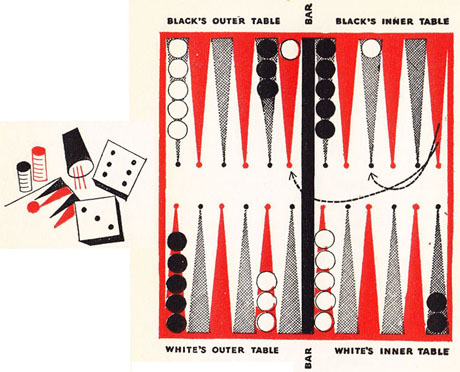
Two men from the opponent’s one-point to the opponent’s bar-point and four-point.
Another poor shake but soundly played as above. The same reasons for the correct play of six-four apply here.
Incorrect Plays
1. One man from the opponent’s one-point to the opponent’s ten-point. Blots are always unwise where recovery is difficult.
2. One man from the opponent’s twelve-point to the player’s four-point. This is incorrect, for it fails to retreat either of the outmost men and makes a 1-to-2 blot out of a well-retreated man.
Six-Two
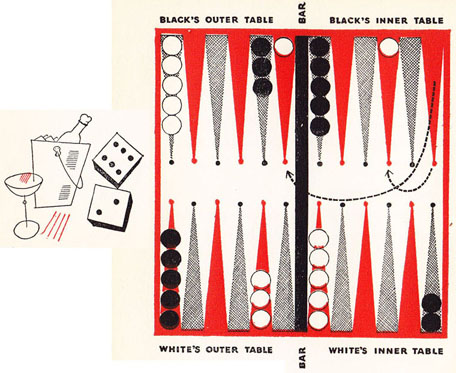
Two men from the opponent’s one-point to the opponent’s three-point and bar-point.
Another poor throw that must he played in the same manner — and for the same reasons — as six-four and six-three.
Incorrect Plays
1. One man from the opponent’s one-point to the opponent’s nine-point.
2. One man from the opponent’s twelve-point to the player’s five-point.
See comment on six-four and six-three.
Six-One
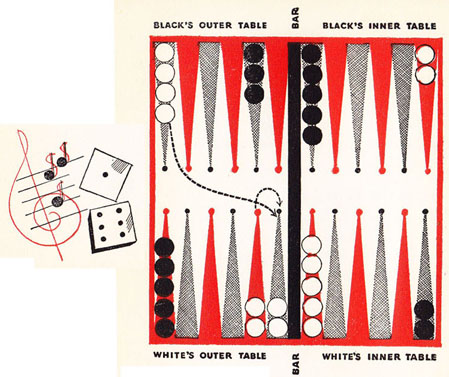
One man from the 0pponent’s twelve-point to the player’s bar-point, and one man from the player’s eight-point to the player’s bar-point.
Next to three-one, the best throw with uneven dice. There is no other possible way to play it.
Five-Four
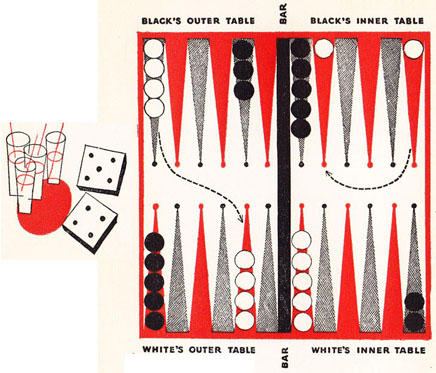
One man from the opponent’s one-point to the opponent’s five-point, and one man from the opponent’s twelve-point to the player’s eight-point.
This is another poor throw, although it allows the player to bring one of his outmost men up to the opponent’s five-point, and to place a man on his own eight-point for building. In the early game, never hesitate to leave blots in the opponent’s inner table; he can only take them safely with point makers. If he leaves a blot when taking you up, there is an excellent chance to send back one of his farthest retreated men while only sacrificing half a shake yourself.
Incorrect Plays
1. One man from the opponent’s one-point to the opponent’s ten-point. Faulty, as the player is too easily hit, without a chance of retaliation.
2. One man from the opponent’s twelve-point to the player’s four-point. Too dangerous.
3. Two men from the opponent’s twelve-point to the player’s eight-point and nine-point. A good building play but neglects to retreat outmost men.
Five-Three
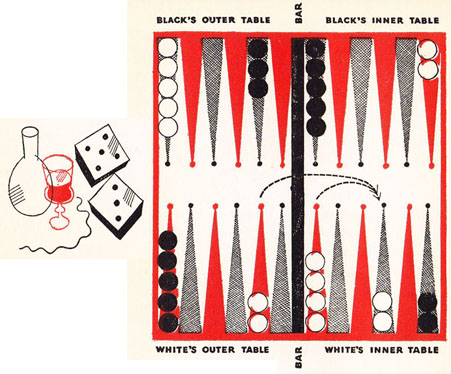
One man from the player’s eight-point and one man from the player’s six-point to the player’s three-point.
A poor throw, best played as above. This is the only opening in which the player retreats men as far as the three-point in his inner table. The men are out of play, but there is no better move.
Incorrect Plays
1. One man from the opponent’s twelve-point to the player’s five-point. The player’s attempt to make the player’s important five-point is commendable, but he is wrong in dangerously exposing a valuable man.
2. One man from the opponent’s one-point to the opponent’s four-point, and one man from the opponent’s twelve-point to the player’s eight-point. Useless.
3. One man from the opponents one-point to the opponent’s nine-point. The odds are 3-to-4 the player will be hit, with small chance for recovery if he is.
Five-Two
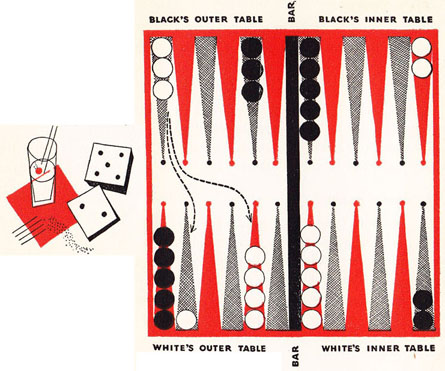
Two men from the opponent’s twelve-point to the player’s eleven-point and eight-point.
This is an exceedingly poor throw and must he played, as above, for building purposes only. To move one of the outmost men on this throw is courting too much danger, with too little gained.
Incorrect Plays
1. One man from the opponent’s twelve-point to the player’s eight-point, and one man from the opponent’s one-point to the opponent’s three-point. Too little is gained.
2. One man from the opponent’s twelve-point to the player’s six-point. Never pile up men on single points.
Five-One
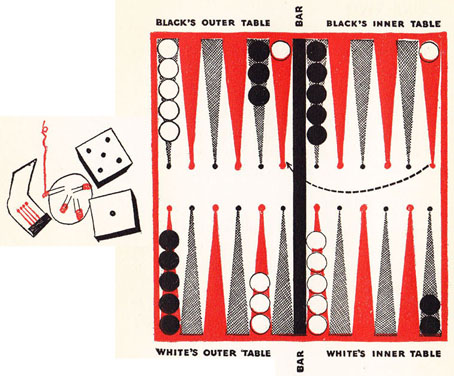
One man from the opponent’s one-point to the opponent’s bar-point.
Another bad throw. Must be played similarly to the six-four opening. The odds that the player will be taken up are 2½-to-1, but the possibility of revenge on valuable blots makes the risk worth while.
Incorrect Plays
1. One man from the opponent’s twelve-point to the player’s eight-point, and one man from the player’s six-point to the player’s five-point. Penalties in Backgammon are swift to those who tempt fate. The man from the player’s six-point is too far retreated to be risked so brazenly.
2. One man from the opponent’s twelve-point to the player’s bar-point. A fatal error.
3. One man from the opponent’s twelve-point to the player’s eight-point, and one man from the opponent’s one-point to the opponent’s two-point. Futile exposure.
Four-Three
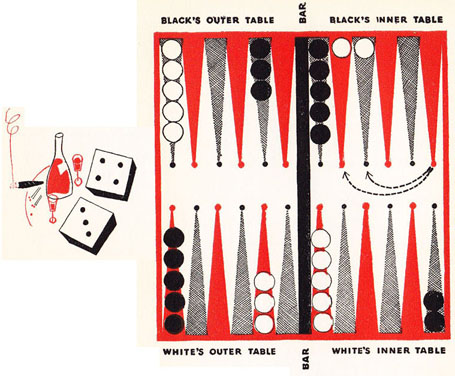
Two men from the opponent’s one-point to the opponent’s five-point and four-point.
Another of the poor throws but soundly played in the opponent’s inner board. The odds that the player will be hit are 7-to-3, but again, he has an excellent chance for revenge, for he is on the opponent’s valuable five-point, and he has retreated his outmost men.
Incorrect Plays
1. One man from the opponent’s twelve-point to the player’s six-point. This piles the men up; a stupid move.
2. Two men from the opponent’s twelve-point to the player’s nine-point and eight-point. Good builders, but can he hit after a long retreat and outmost men have not been moved.
Four-Two
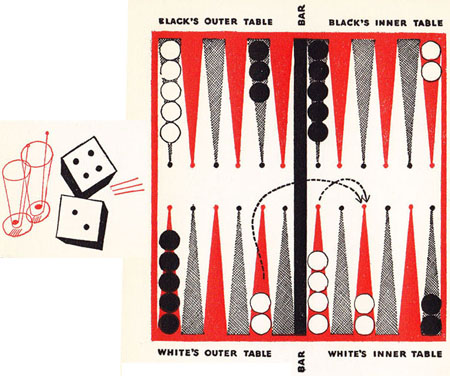
One man from the player’s eight-point and one man from the player’s six-point to the player’s four-point.
An excellent throw. The only way to play it.
Four-One
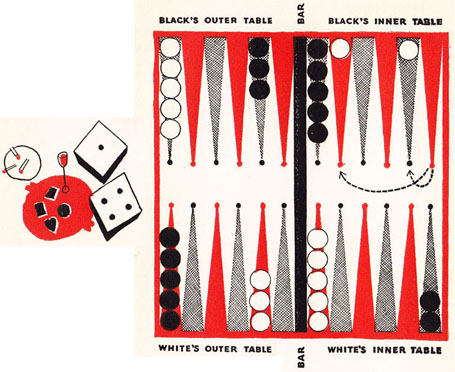
Two men from the opponent’s one-point to the opponent’s five-point and two-point.
A miserable throw. The player makes an attempt at the opponent’s five-point and retreats his outmost men a little.
Incorrect Plays
1. One man from the opponent’s twelve-point to the player’s nine-point, and one man from the player’s six-point to the player’s five-point. Do not expose blots in your inner table unless it is absolutely necessary.
2. One man from the opponent’s twelve-point to the player’s eight-point. Useless.
Three-Two
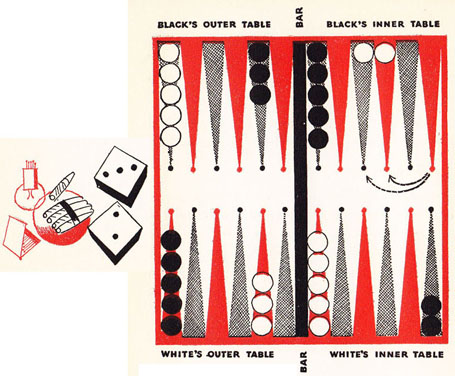
Two men from the opponent’s one-point to the opponent’s four-point and three-point.
A weak throw. Outmost men are retreated; the opponent’s five- and four-points are threatened.
Incorrect Plays
1. One man from the opponent’s twelve-point to the player’s eleven-point, and one man from the player’s eight-point to the player’s five-point. Dangerous exposure which is not worth while.
2. Two men from the opponent’s twelve-point to the player’s eleven-point and ten-point. Risky exposure of valuable men. Outmost men forgotten.
3. One man from the opponent’s twelve-point to the player’s eight-point. Useless.
Three-One
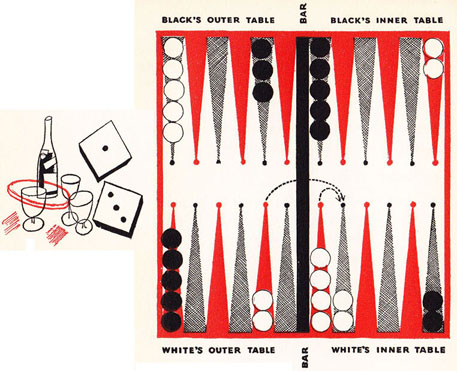
One man from the player’s eight-point and one man from the player’s six-point to the player’s five-point.
The best opening throw with uneven dice. Makes the player’s immensely valuable five-point.
Two-One
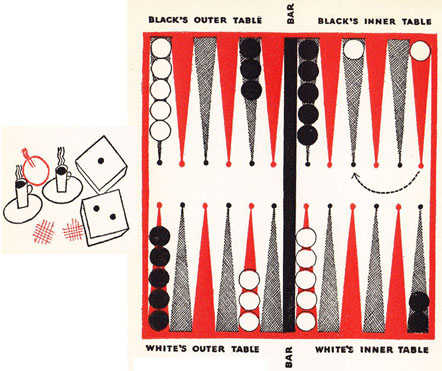
One man from the opponent’s one-point to the opponent’s four-point.
The worst shake on the dice.
Incorrect Plays
1. One man from the opponent’s twelve-point to the player’s eleven-point, and one man from the player’s six-point to the player’s five-point. Unnecessary risk.
2. One man from the opponent’s twelve-point to the player’s ten-point. Accomplishes nothing, and exposes a blot valuable to the opponent.

Chapter III. The Four Games
In Backgammon four types of campaign are used by the experienced player, the choice depending on his own position and the position of his opponent. In a single game he may use one of these systems of campaign only, or he may use all four as his position changes with the fall of the dice. The four games are the position game, the blocking game, or side-prime, the running game, and the backward game. Each has a distinct and special use. Proficiency in Backgammon comes quickest to the player who knows best when to adopt or abandon each game.
The novice cannot be expected to master these styles of play until he is thoroughly familiar with all the fundamentals; in fact he will not even recognize them when they are being used against him. But the experienced player depends on the different virtues of the four campaigns to bring him victories.
a. The Position Game
The position game is the fundamental strategy of Backgammon. It consists simply of biding one’s time and taking advantage of every favorable opportunity. In other words, it is an intelligent retreat. The perfect position game would be the one in which an average sequence of throws allowed the player gradually to withdraw his men into his home table without a casualty. To approximate this perfect game is the art of the accomplished player.
The science of the position game is caution and conservative play. Let the opponent make the openings, let him take the risks, make the bold plays: the player can pursue his sound policy of watchful waiting, and, profiting by the opponent’s mistakes seize his opportunity when it presents itself and skip off with the game. The position game in Backgammon is what is called scientific play in all other games. It corresponds closely to what is known in baseball as the batter’s “waiting out” the pitcher; it resembles, in boxing, skilled fighters sparring for points; it approximates, in yacht racing, the boats jockeying for the start.
The strength of the position game, aside from its virtues per se, lies in the ease with which it may be abandoned. If this is a paradox, it is none the less true. For, unusual throws of the dice by either player or opponent may suddenly make the abandonment of the position game expedient, if not absolutely necessary; and the switch to one of the other games is made easy by the very sound nature of the position game itself.
Thus, if the opponent suddenly makes a mad dash for home (the running game), the player can easily change his style of play to any one of the other three games; he can, if he finds himself even with, or ahead of his opponent, also play a running game; or he can, if he is behind, but in an advantageous position, try for a side-prime (the blocking game); or finally, if he is sadly at a disadvantage and likely to be thrashed decisively, he can try to capture the opponent’s inner table and extend the game as long as possible (the backward game). The reason why such quick switchings to different games are frequently disastrous in every-day Backgammon is, that the player’s position, when the time comes for him to switch, is unsound; he has not learned the inestimable value of an orthodox position game.
Now if the opponent is also playing a sound position game and refuses to make the first break, an interesting situation arises which has two possibilities: either the careful jockeying will continue until the game is almost over and then, simultaneously on both sides, switch to a running game with the outcome dependent upon the fundamental soundness of the positions and the throws of the dice, or, the player himself will make the break, accepting a favorable opportunity and quickly running, or blocking as the case may be. This latter eventuality, not infrequent when the player is playing against an experienced opponent, almost always presents a situation that is Backgammon at its best; it is here that the fine points of the game, the delicate skill, the exacting play, come into their own. This is the part of the game that the novice and the “new” Backgammon player never experience. This is the final explanation of why Backgammon is a game which enthusiasts play from childhood until death.
It would be impossible — unless one wrote a tortuous ten thousand page text book (and doubtful even then) — to explain just when the player should abandon a position game for another tactic. The possible positions and combinations number into the millions; to illustrate half a dozen would be to confuse the reader on a thousand. Therefore it is only possible to give general rules and admonitions which will be found in the next chapter.
Fortunately, for the beginner, the three other games, the minor tactics, allow a more matter-of-fact explanation. What to do, once these tactics have been started, can be told briefly.
b. The Blocking Game
The blocking game may be defined as the series of moves by which the player attempts to impede and finally halt the retreat of the opponent’s forces (normally the two outmost men), by erecting a sequence of six or less points. If six successive points are each occupied by two or more of the player’s men, the opponent obviously cannot pass. This is a blockade or side-prime.
The usual side-prime is erected with the player’s eight-, bar-, six-, and five-points as nuclei, the first and third being in his possession at the set-up and the second and fourth being major objectives of the early game. Once they are secured, the opponent’s outmost men cannot escape except with six-three, six-two, five-three, or double-threes and a five or a six; not only are these compound throws hard to get twice — as two men must be carried out — but even when they are shaken they carry the outmost men only further into exposed positions where it is safe for the player to hit them again. And if the player shakes a four-two and double-fours (provided he has a builder on his eight-point), or any one of the many other combinations, he can secure his four-point and his nine-point, thus completing a perfect side-prime.
With this primary objective of the blocking game accomplished, the player must pause and survey the board. At Backgammon, surveys of the board and position can never be made too often. The player must judge (a) whether it is to his advantage to revert to a cautious position game, take up as many men as he can, and try for a gammon or backgammon, or, (b) play a persistent running game and get his other men around to his side-prime as expeditiously as possible. If he decides on the position game, he must first of all secure the remaining points in his inner table and then commence a general retreat, taking up as many of the opponent’s men as he can on the way; but if he decides on the running game he must engineer his retreat first and make up his board only incidentally as he brings in his men.
The player’s judgment here will be influenced vitally, of course, by the tactics the opponent offers in rebuttal: if the opponent concentrates on building an impregnable inner table with the hope of catching a blot when the side-prime eventually must be broken up, the player should run; if the opponent immediately begins a backward game, the player should attempt nothing more than to extend his side-prime until it completely covers his inner table, under no circumstances whatsoever taking up a blot. When his inner table is completed, with the exception of his one-point which the opponent’s outmost men hold, the player can and should play as openly as he knows how, taking up blots and leaving them.
The reasoning behind these tactics is as follows:
First, as to judging which game to play after the side-prime is complete and the blocking game therefore abandoned: if the player’s men have retreated considerably farther toward his home than the opponent’s men have retreated toward their home, the player must run; it is the simplest thing for him to do, he will almost surely win a single game, conceivably a gammon. But if the player’s remaining men are not advantageously placed, he must embrace the position game and bide his time. This he can well do as his side-prime gives him a strategic superiority. Even if he is taken up, the player still retains this advantage, for the opponent cannot pass the side-prime until it is broken, which will never happen with the player on the bar.
Second, as to the play of the running game, should the player decide on it or the opponent force it by closing his (the opponent’s) inner table: the retreat must begin with the outmost men; if the opponent has a partial blockade, this is particularly important; the outmost men should be moved with the one- and two-throws as well as the doublets — being hit cannot hurt them now. The other men should be retreated first to the player’s nine-, eight-, and bar-points and, only after they have all been brought up, into the inner table.
This is to insure against high throws forcing the player to leave a blot at the very end of the game. Once all the opponent’s men have been passed, save the two which are blockaded, the player must enter his inner table cautiously, making additional points wherever possible, and guarding against alignments on his outer side-prime points, which will leave blots if combinations with six are thrown. When all the player’s men save two (on his bar-point) are safe in his inner table, it is impossible, with the opponent’s two outmost men on the one-point, to guard against one contingency — a throw of six will leave a blot on the player’s bar-point. Many a seemingly certain victory has been dissipated on this particular play: it can be avoided, obviously, by bringing the men from the bar-point in before moving the men from the eight-point. Even so, there is danger — the student will find that he cannot be too careful in the tricky manoeuvers attendant upon safely reducing a side-prime.
Third, as to the play of the position game, should the player decide on it, or the opponent force it, by adopting a backward game: the player must — and this point cannot be stressed too strongly — secure all the remaining points in his inner table before taking up a blot. The opponent must be allowed no further foothold in the player’s board or the side-prime will collapse with a sickening crash. The opponent is trying to get behind the player so that he can demoralize his strategy by hitting men which will have to be exposed when the side-prime is broken up and there are not enough points held in the player’s inner table to receive the entering men.
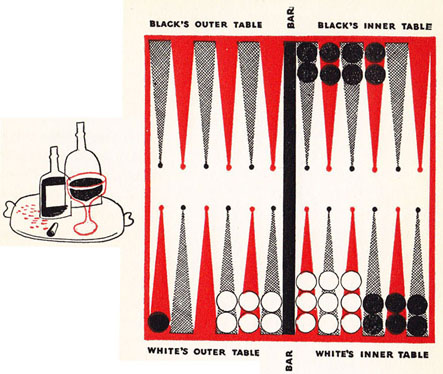
Diagram 4
For instance, if the player has recklessly hit all the blots which the opponent has left for him, the situation shown in Diagram 4 could very well arise. Black (opponent) controls White’s (player’s) one-, two-, and three-points while the side-prime is still unbroken. It is White’s shake. To the casual observer White’s position may seem a strong one but in reality, it is fatal. White is almost certain to lose a single game, perhaps a gammon. If he shakes any combination of six and another number, he will leave a blot; if he escapes being taken up on the first throw he is almost sure to be hit on the second or third, the danger increasing with each shake. It is impossible for him to escape from this predicament except by a sequence of incredible dice throws. (This is an interesting and informative game to play out for practice. Remember, it is White’s shake.)
Accordingly, the player must always make every effort to complete his board, when opposing the backward game, before he hits a blot. Once he has completed his board, he must hit every blot he can and come home as slowly as possible; because he can thereby cripple the opponent by giving him only one point of re-entry, the one-point, and, by hitting more blots, pile up the opponent’s men on the one-point and win a gammon or backgammon. No matter how many men the opponent has on the player’s one-point, they will be of little use to him if the rest of the board is held by the player.
In brief, the offensive action which has culminated in the erection of a side-prime changes abruptly with its successful completion to a defensive operation which involves either a swift retreat to the side-prime (the running game), or a consolidation of defense in the inner table and then a further offensive to capture enough men to assure a gammon or backgammon (the position game).
As for the counter-blocking game, the reader, from noting what not to do in the foregoing, can get a good idea of its principles. It consists, simply, once the side-prime has been successfully erected, of adopting one of the following three tactics: (a) erecting a counter-side-prime, (b) building a closed board and awaiting possible captures, and, (c) playing the backward game.
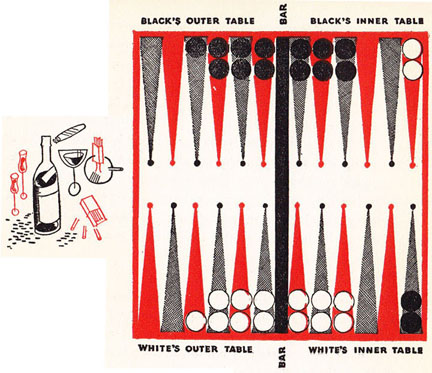
Diagram 5
The first is a very unusual procedure occasioned by both players throwing the same high dice all through the early game. Carried to a perfect extreme, it would result in the position illustrated in Diagram 5. This is an interesting game to play out; the student will find it worth while to set up the men as shown, and play it through several times. The subsequent moves demand all the caution and delicacy typical of expert Backgammon play.
Attempting to counter the blocking game by building a solid board, when the two outmost men remain on the opponent’s one-point, is the most sensible procedure of the three listed above. When it fails, as it does more often than not, this play rarely results in a loss of more than a single game. Diagram 6 illustrates the position. All Black can do is make points in his inner table and trust in his dice. It must be remembered that a side-prime, once established; usually wins a game.
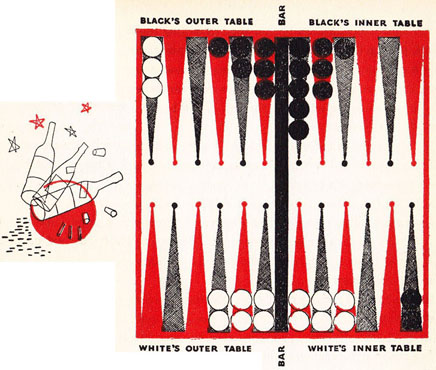
Diagram 6
The backward game as a counter to the side-prime has many disadvantages, the worst of which is that, if unsuccessful, it nearly always ends in the loss of a gammon or backgammon, while if it succeeds, a single game only may be won. The play of the backward game will be explained at the end of this chapter.
All in all, the blocking game is a powerful weapon in the hands of a player throwing high dice and should be developed carefully as directed above: to oppose it, run for home as fast as you can, especially with the two outmost men; but if the outmost men are caught, strengthen your inner table, wait for a break — and be prepared to lose a single game.
c. The Running Game
The running game is the simplest, the least demanding, but frequently the most exciting tactic in Backgammon. It is occasioned by a series of high throws in the early game on the part of one or both players and consists mainly in getting the men home and off the board in the quickest possible time.
There are a few rules to remember in playing the running game: the most important are these: 1. Always extricate and retreat the outmost men first, 2. Avoid hitting blots unless your inner table is closed or nearly closed. 3. Once past your opponent, try to play your shakes so that each number will take a man into your inner table. 4. If your opponent is also running, avoid being the first to expose blots when the last few men are passing each other.
The counter-running-game is either another running game, an attempt at blockade somewhere along the path of retreat, or the backward game, depending, as always, upon the relative positions. Generally speaking it can be said that, if the opponent is running but not far ahead, the player should run also; if the opponent is considerably ahead, a blockade should first be attempted and, failing that, the backward game.
In countering with another running game, the player must hit more blots, take more chances, than he would if he were ahead, and depend to a certain extent on getting more favorable dice than his opponent. If he counters with a blockade, he must do so early in the game and direct every effort, regardless of risk, towards erecting a partial, or complete side-prime. Lastly, if the player counters with a backward game, he must do so even earlier in the game and must be willing to lose a gammon or backgammon — always possibilities when this tactic is adopted — if he fails.
The usual end of a running game, when one player forges ahead, is a double and resignation.
d. The Backward Game
The backward game is the most overemphasized, overvalued, and overplayed tactic in Backgammon. In at least three cases out of five, it ends in a gammon or a backgammon for the player who uses it without restriction; in the fourth case it ends in the loss of a single game; in the fifth a doubtful victory. In fact, this strategy, which is the one artificial element in the game, ends so frequently in disaster that the inexperienced player should never employ it, and the expert only on those rare occasions when his position is utterly hopeless.
The principle of the backward game is this: when high throws of the dice have advanced the opponent past most of the player’s men, or when the player has had one or more blots hit other than his outmost men, the player may begin the game again by getting behind the opponent and forcing him to pass by once more. During the second passing, the player hopes to be able to hit the opponent’s blots one after another until he has returned enough of them to his (the player’s) own board to equalize the positions again, and begin the running game once more, with the same opportunities he had when the game began.
In theory this is an excellent tactic, but in reality it is faulty — because it depends on the opponent’s cooperation for success. In other words, unless the opponent takes up the backward game player’s blots, no backward game is possible because the player cannot get behind the opponent except by being taken up. An attempt to get around this is made by the player of the backward game taking up all the opponent’s blots he can while at the same time leaving as many of his own blots as possible in his inner table, so that the opponent cannot enter his men without taking up the player’s blots. Experienced players, however, are rarely led into this predicament.
The only occasion when the backward game should be adopted without question is when the opponent opens with double-ones and the player’s first throw is not a good one. The double-ones give the opponent his eight-, bar-, six-, and five-points, a position the strength of which cannot be overestimated; if in conjunction with this beginning, the player’s own first throw is weak, he has only one alternative — the backward game.
In developing the backward game from this beginning, all the rules of Backgammon are reversed. That is, the retreat towards the player’s home table becomes an advance towards the opponent’s home table; the outmost men, instead of being immediately extricated, are held on the one-point as the key to backward game play; blots are strewn about, every risk taken, every principle turned upside down. From then on it is the player’s one desire to be hit as many times (up to four) as he can be, to get as many men (up to six) as he can in the opponent’s inner table.
This strategy, as has been pointed out, is only successful when the opponent can be forced to take up the player’s blots. Therefore the player must first uncover men all along the path the opponent must follow in running home, and then place blots in his own inner table so that the opponent, when entering, will be forced to hit them. As the player — supposing his tactics meet success — enters men in the opponent’s table and consolidates a position there, he must begin to secure points in his own inner table, the better to keep out the new blots of his opponent which he expects to hit on his way home. The men not in the opponent’s or his own inner table, the player should spread out in the two outer tables as catchers for the opponent’s men which have been taken up and are attempting to return home.
This procedure must be kept up until the player, having taken up many of the opponent’s blots and sent them back, and having now moved some of his own men out of the opponent’s inner table, judges that he has not only caught up with the opponent in position, but has passed him, and is actually ahead. The player will then abandon the backward game, resume the position game, or even adopt a running game, while the opponent, depending on the strength of his position, will continue his running game, fall back on a position game, or himself adopt the backward game.
But let the student remember that, for every successful backward game as outlined above, there are four unsuccessful ones — a single game loss and three gammons or backgammons.
Defense against the backward game should be clearly understood by this time. Remember, simply, never to take up an opponent’s blot unless your board is closed, and to abandon the running game with its necessary exposures for a cautious and careful position game, aimed first of all at preventing your opponent from getting behind you. If you prevent him from doing that, he has lost.
Again it must be repeated that the backward game should never be employed by the novice, rarely by the experienced player, and by the expert only when everything else fails him or he is confronted by an opponent opening of double-ones and a weak initial throw of his own. It is better to lose a single game without a struggle than to lose a backgammon with a complicated and long-drawn-out defense.

Chapter IV. General Strategy
Position is to the Backgammon player what a knowledge of the location, strength, and condition of his own and the enemy troops is to the army commander. Successful progress without this exact knowledge is as impossible for one as for the other. The army commander may find it difficult to estimate his position truly, but the Backgammon player need have no such tr0uble — the board, the men, the alignments are all before his eyes. All he need bring to the task of estimation is a quick discernment and the ability to judge strength and weakness. Before he has any pretensions of becoming even a good player, he must master this neglected fundamental.
The two basic principles of the game, to continue with these general rules, must never be allowed out of sight. First, retreat the two outmost men at every logical opportunity. And, second, never take an unnecessary risk.
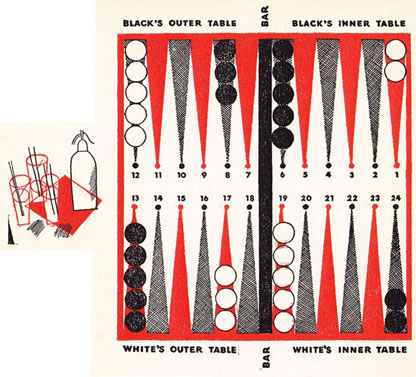
Diagram 7
The almost universal success of the side-prime — a strategy dependent on the capture of the outmost men — is a case in point for the first principle. The second is well illustrated by Diagram 7, the numbers on which show how many points each white man may be considered retreated from Black’s one-points. Supposing that one man from White’s six-point, is played to his five-point, what is the risk? That man, a blot, on the five-point, represents a move of just nineteen points away from Black’s one-point. Accordingly, if he is hit by Black from his own one-point (which requires a move of only four points to do so), the net loss to White is a move of fifteen points, plus the loss of one point on whatever number he shakes to reenter Black’s inner table (if a three, he enters on a point only two away from the one; if a five, only four away, etc.). Therefore the risk White takes to secure his five-point — and that may not work out — by exposing a blot, costs him a move of exactly sixteen points. In other words, he has thrown away double-fours.
The player is not expected actually to count up how many points each man is away from the one-point — though such procedure would not do the beginner any harm; but he is expected to realize that a man on his five-point is considerably more valuable than a man on the opponent’s twelve-point, simply because his position represents a retreat of seven spaces more. Mathematically, the man on the five-point is over a third more valuable than the man on the twelve-point; and should therefore be risked less than a third as much.
Proponents of a reckless game have one cherished rule on this subject which they preach passionately. It is: “Take your risk early in the game.” The unsoundness of their Backgammon can never be better illustrated than by this statement. For a risky play early in the game jeopardizes the victory almost as must a risky play later in the game. Risks are always dangerous. The perfect Backgammon game would be one in which no blot was exposed until the opponent’s men had been passed. The amount of risk attached to a play is ascertained, as has been pointed out, by the retreated value of the man in question, and by the possibilities of reentry in the opponent’s board.
When playing the various shakes, aside from the openings, there are several generalizations which can be made. When possible to do otherwise, never move to a point of which the six-point is held by the opponent, and, conversely, always attempt to have two or more men on the point six spaces away from the position of one, or more, enemy markers. The reasoning behind these rules is obvious — if you have a point built six spaces away from an enemy man, he cannot run with double-sixes, and if you can avoid getting in that position yourself, you will always be ready to run when the dice give you doublets.
In this connection it is well to point out that, as doublets win a large proportion of Backgammon games, the player who is most often in a position to use them when they are thrown is most often victorious. For this reason it is always poor policy to occupy the two-point in the opponent’s board, that point being controlled, as far as double-sixes are concerned, by the opponent’s eight-point. If the opponent makes his bar-point, the player should move his outmost men to the three-, four-, or five-points as soon as he can. Always be ready for doublets. If the student will note, in his next few games, how many times doublets fail to move important men because the men are badly placed, or, indeed, how many times big doublets cannot be played at all, he will realize the value of keeping the path of his retreating men free.
Still another point in this connection arises when the player has completed a side-prime and has his other three men in his outer board, or in the opponent’s outer board. In this situation, the risk not being too great, the player should leave one of his men as far out as possible, and should play the other two up to the side-prime and along to its end before touching the third man. The reason for this is that it pays to keep the third man as a means of playing high throws should they come before they are wanted: in other words, instead of being forced by a high throw to break up the side-prime before the player is ready to, he can spend that throw on the third man.

Chapter V. Bearing Off
In the final stage of Backgammon, bearing off, there is less skill than in any other part of the game. That this should he so is, of course, due to the fact that there is less opportunity here for moving men from one point to others, and deploying them in particular formations.
There is thus only one principle in bearing off aside from the mechanical regulations which are discussed in Chapter I, Part I — and that is: get as many men off as the throw allows, first; and the men moved into position to he cast off second. As the most simple illustration, suppose double-threes are thrown and the three-point is blank; in that case the correct play is two men off the six-point and not four men from the six-point to the three-point. More complex, but not more seriously puzzling, instances of this rule appear in almost every Backgammon game.
A board with men on every point is more quickly cleared in bearing off than the usual board which has a preponderance of men on and near the six-point. Despite this fact, the player should never, when entering men in his inner table in the later stages of the game, play a man up in the inner table in preference to bringing a man in, or moving one along outside. Enter first. After you are in, you may have to play them up, on the other hand you may shake high dice and not have to play them up at all. This is another of the many instances in Backgammon where the skilled player takes advantage of even the most minute mathematical chances in his favor.
When the opponent has one or more men in the player’s inner table there are, naturally, added complications to bearing off. As the opponent’s inner table will most likely be either closed or almost closed at this stage of the game, it is of paramount importance that the player bear off his men without leaving blots. To do this he must be careful not to have an uneven number of men on his highest point, unless the number is also uneven on the next highest point. This is to guard against a throw of doublets taking off so many men that the player will be forced to leave a blot. For instance, if the player has three men on his six-point and two on his five-point, and then throws double-sixes, he must leave a blot on his five-point in order to throw off four men; but if he has three men on both the six- and five-points, or an even number on both, he escapes exposure.
If, in this situation, there is no chance for the player to win a gammon or a backgammon, at every opportunity, excepting those obviously safe, he should move men up, instead of bearing them off. Correspondingly, if there is an opponent’s blot on the bar, the player should strive to open his six-point first, so that the opponent cannot succeed in entering behind him.
On the other hand, if the player believes he has a good chance of winning a double or triple game, and especially if the opponent’s board is open, he should bear men off at every opportunity that does not force him actually to leave a blot. In brief, he should take a chance when sure of a single game in any eventuality, but be careful when the game is still in danger.

Chapter VI. The Double
Of the two modern adaptations of Backgammon — the Double and Chouette — the former is the important one. There can be no question that its introduction has had a great deal to do with bringing the game to its present popularity, and although personally the author prefers to play without it, there is no gainsaying that the Double does add excitement, and a certain gambling color to the game. If you want to gamble, by all means play the Double; if you are more interested in the strategy of the game, omit it.
There is a good deal of skill involved — unbeknown to many of its admirers — in manipulating the Double; simply because it is impossible for a player to double wisely, or to accept or reject doubles wisely, unless he has at all times an accurate knowledge of the comparative values of his own and his opponent’s positions. The player does not want to double the stakes unless he is so far ahead that, with dice as good as his adversary’s, he is sure to win. In the same way, he will never accept a double if he is so far behind that only extraordinary dice will bring victory.
Therefore, if two absolutely perfect players engaged in a match, there would never be an accepted double. In other words, a correct double is one that is made only when the doubler is definitely ahead; and a correct acceptance, likewise, is made only when the accepter knows that he is not definitely behind. Consequently, if every double made were perfect, none would be accepted, if every acceptance were perfect. We must conclude, then, that accepted doubles can only be the result of imperfect play on the part of one adversary or the other.
The author’s chief objection to the double is precisely this — its only raison d’étre is the incompetent play of those who use it. For there can be no final difference of opinion on the value of position; the men are on the board before our eyes, all that is necessary is to estimate their strength; two expert players will never disagree. Knowledge at Backgammon, after all, is finite.
But, as long as the vast majority of players are not expert, the Double is with us to stay. Accordingly, a few words on its manipulation in every-day play are necessary here.
Perhaps the most important thing to remember about the Double is that the less it is used the better. For, if a double is made and accepted, the doubler is immediately at a tactical disadvantage, provided the acceptance was not foolhardy. This is true for the reason that, after the double, the accepter is the only one who has the right to double again, whereas before the double, both players had the privilege; and the right to double is the valuable part of the tactic. Also, the doubler increases the stake to two stakes when he has what he considers to be an advantage, while the redoubler is able to quadruple the stake whenever he thinks he has the advantage. Accordingly, be wary of being the first to double; as in the position game, wait for the opponent to make the break, unless, of course, your advantage is preponderant.
The careful use of the Double is most important in the early game; rarely should a double be made then. There are two good reasons for this: First, in the early game there is still so much play to come that the opponent has many opportunities to improve his position to a winning one by fortunate throws of the dice or skillful play; second, a position strong enough to call for a double in the early game may improve in the play to come until it accomplishes a gammon or backgammon, in which case two or three games will be won by the would-be doubler, instead of a single. In the same way and for the same reasons, doubles should more readily be accepted in the early game and more rarely in the latter stages. The accepter has always a chance to improve his position if he takes the double early enough; while if he accepts it in the end, his chances are decidedly limited.
In this connection, the cardinal rule of making or accepting doubles is: “Never depend on the dice.” When you propose or accept a double, presuppose that from that point on, your dice will be just as good as your opponent’s but not one pip better.
Many players double, fallaciously, when opening with double-sixes, double-fours, or double-ones. Such doubles should never be made; but when made by the opponent, should always be accepted. If the accepter throws double-sixes or double-fours after taking a double made by his opponent on a similar throw, he is not only even with the doubler in position but has the tremendous advantage of being able to redouble whenever he forges ahead. If the double is made on an opening double-ones, the accepter has an even chance of winning with a backward game, starting as he is from one of the few positions favorable to the successful development of that tactic.
Of course, there are times in the early game when a double is good policy. For instance, if the player has made his bar- and five-points and has advanced his other men, including the outmost men, while the opponent has escaped with one of his outmost men and has the other on the player’s four-point, and the chances of a gammon look slight, the player may double, knowing that a general running game is about to develop and that the advantage lies with him. Such a double should, of course, be rejected. Also when the running game is in full swing and all men have passed by, the player who is one shake or more ahead should double. This double should also never be accepted.
Definite instructions as to the use of the Double can be given for only one stage of the game — bearing off. In this end game, the player who is one-half a shake or more ahead, the positions being equal or in his favor, should always double; the opponent in this situation should always resign. There is no question here; the man who is ahead by so little as one-half a shake will always win if the dice are equal. Inasmuch as we cannot base our play on expectations of better than equal dice, the adversary must resign. A case in point: Black, say, is one half-shake ahead when, with equal positions, he has one less man thrown oft than White and it is his (Black’s) shake; from that point on, if each player throws off two men per shake, Black will win by the margin of one man. If Black has the same number of men thrown off as White and it is Black’s shake, he is one whole shake ahead, and so on. Equal position means that Black has the same or corresponding points covered in his inner table with the same number of men.
Two other points should be remembered. First, that it is very dangerous to play the backward game when doubled; as it has been pointed out, this tactic frequently ends in the loss of a gammon or a backgammon; to double the loss is disastrous. Secondly, when the player is well ahead and considering a double, he should always pause to calculate whether he has a chance for gammon or backgammon; if he has this chance and doubles, the opponent will naturally resign and lose only a single game. But if the player withholds the double, he may win a gammon or a backgammon and can always, if his adversary’s position improves, double later.

Chapter VII. The Odds
Odds in the casting of dice are, as the odds in any other unknown force outside the control of man, based solely on mathematical hypothesis. This hypothesis supposes that if a die were thrown an infinite number of times, each of its six faces would come up the same number of times. The strategy of Backgammon is based on this hypothesis, and the science of the game is always to take advantage of the mathematical odds in the player’s favor.
These odds are determined as follows: For instance, in discovering just what chances a player has of throwing a six on any one cast of the two dice, we add up all the possible ways of making a six. These are:

This makes a total of seventeen. There being thirty-six possible combinations on the dice, we subtract seventeen and get nineteen. Therefore, the odds against throwing a six on any one cast are 19-to-17, or roughly, 9-to-8.
The player should have a general idea of what the odds against his opponent’s throwing any certain number are. With this knowledge, he will leave blots, whenever possible, only in positions where the odds against them being hit are high. In the following table the odds are given roughly rather than exactly to make their memorizing more simple:
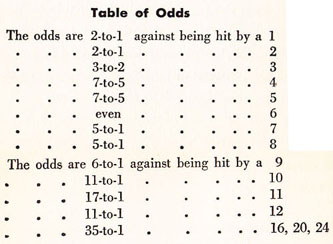
In using these odds to estimate the chance your opponent will have of hitting a blot which you are about to leave, remember that they are accurate only as long as there are no occupied points between your man and the opponent. For example, if you leave a blot six points away from your opponent and the board is vacant in between, the odds are 8-to-9 that he will hit you; but, if you have two or more men on points between your blot and your opponent’s men his chances of hitting you are diminished. Suppose that you control in-between points, one of them three spaces from the opponent, another four, and the last two spaces; then the opponent will be unable to hit your blot with double-threes, four-two, or two-four, which will diminish his chances until the odds are 5-to-3 against him, instead of 9-to-8. The player must always take these possibilities into consideration.
The only other set of odds necessary to know are the following, which tell you exactly your chances of re-entering your opponent’s inner table under all conditions:

It is well to remember these figures when your opponent has a good board and you feel like taking a risk.

Part III
For Every Player
— C. B. B.

Chapter I. The Etiquette of Backgammon
The year nineteen-thirty was a memorable one in the world of fashion, for it saw the romantic revival of long skirts, a crash (with social reverberations) in the stock market, the sprightly advent of Tom Thumb Golf, and the sudden and widespread vogue for the ancient and all but forgotten game of Backgammon. Now, some philosophical soul might find in the extraordinary popularity of this latter fad a combination of the elements of all the other three: like long skirts, its reversion to antiquity is a pleasant revolt against a too rigid modernism. Again, the game is an exciting, if miniature, re-enactment of the stock market crash, with its sudden adventurous ups and downs, its rapid, unpredictable and dizzy turns of fortune. In addition to this heady wine of chance it offers the same mental hazards and imaginative possibilities as Miniature Golf. Thus the philosophical soul might make an excellent case for the theory that this latest parlor phenomenon, Backgammon, which is both modern and romantic, dangerous and frivolous, lucky and skillful, presents a perfect portrait of the modern mind.
However that may be, Backgammon is here and, we may suppose, here to stay: meaning, exactly, that it is here to stay until some game with more exciting possibilities is evolved, invented, or resuscitated. To prove that Backgammon (unlike the late unlamented Mah-Jong) is not a transient vogue, several fair-sized volumes about it have already appeared.
But none of them until now have contained a word about the etiquette of this game — a deplorable omission, for, as any Backgammon fan will tell you, there is no game, not even Contract Bridge, in which a player, without infringing any of the written rules, may be more annoying, more irritating, and more of a bore to his opponent, than at Backgammon. The variety of ways in which a man or woman, armed with a dice-cup and dice, can sit down before a board and quite unconsciously, perhaps, exasperate or exhaust an adversary, are numerous enough to deserve some mention.
Into the category of Backgammon nuisances the blatant novice does not precisely fit, for while he is an obvious bore to the experienced Backgammoner with whom he insists on playing, he is often a blessing in disguise, a lamb preparing himself for the slaughter, something, one might almost say, handed to you on a silver platter. And unlike the Bridge novice who assumes, with disastrous and embarrassing results, the responsibility of a partner, the Backgammon neophyte is on his own — lives, dies, doubles, and loses on his own. And while it is always tedious for an expert to play Backgammon with a novice the monetary rewards usually make it (to speak brutally) well worth while.
But the trying habits of the experienced opponents — who can ably roll their own — are those which have made more than one backgammoner vow never to throw a pair of sixes again.
First, there is the lazy player (women are the greatest offenders in this) who sets up the board and arranges the men in as leisurely a fashion as if only one game were to be played every three hours — meanwhile chatting, smoking, or drinking, and then at long last, noticing, with a little gurgle of amusement or embarrassment, that her board is set up quite differently from your own, her inner table away from the light. While you gallantly start rearranging your board to match hers, the lazy player begins apologetically to do likewise, so that the whole performance becomes a constant shifting and pushing of men to all four corners of the table. (The simplest way with such scatter-brains is patiently but firmly to say, “May I set up your board for you?”)
The slow player is the over-thoughtful one who ponders for long, weary minutes over every possible and probable move-combination of his throw, and takes also into lengthy consideration the chances of your next throw. In a game whose greatest charm is a certain swift and fluid quality whose only convention is speed, the exaggerated brain-rackings of a slow player are both tedious and out of place.
One of the worst backgammon offenders is the cup rattler. With infantile glee, he grasps his dice-box in his hand, and from the moment your first throw is made to the moment his last man is borne off, he frantically, loudly, and passionately rattles his dice. Nothing can stop him, for the better your throw, the more vigorously he rattles his box, and when he himself is winning, it sounds like the gourds of an entire Havana Rumba band, without, one might add, the exhilarating cadences of those primitive instruments.
There is also the fast shooter. This type of pest never waits until your dice are back in your box to hurl his own upon the table with the speed of a machine gun, and his do-or-die expression manages to make you feel as if the destiny of an empire hung upon the cast of his dice. In his painful eagerness to see what that destiny will be, he acts as though he hoped to see, not only double-sixes, but quadruplets as well.
Again, there is the school-teacher player, who knows just as well as you and I, or his youngest child, that three and two make five, but who, in a raucous and cheery voice, counts out every throw something like this: “Well, there’s my three, and there’s my two! And here’s a four, and there’s a six. And that’s one one, and that’s two ones, and that’s three ones, and this makes four ones!”
Another variation is the point-counter, who, holding his man between a tense thumb and forefinger, loudly taps every point, droning like a bee. “One — two — three — four — five — and six. (Down the man goes, thank heaven!) And one — two — and three!”
A still noisier player is the one who literally scales his men from point to point, throwing them across the board as if it were a bowling alley, and knocking your men off like ninepins. This is usually accompanied by a great air of skill and assurance, as though he were the greatest and swiftest backgammoner at the boards.
The cock-dice thrower, who in his enthusiasm for good rolls, throws into your board, into an ash tray, on the floor, or under the piano, is another pest, particularly so, as by some evil (or lucky) chance, his cocked throw is usually an excellent one, and when he must take it over again, he breaks out into a whole train of laments against his ill luck and bad fortune.
This type quite naturally leads us to the grouser. He is also found on the golf course, complaining bitterly of poor lies, and at the bridge-table, of wretched cards. But when he enters the Backgammon lists, the board becomes a veritable wailing wall, and after his first bad cast of the dice, he lifts his voice in a pathetic apostrophe to the Gods of Chance: “That,” he exclaims, “was the worst throw I could have had! Anything would have been better! I always throw the most terrible dice in the world! I’ve never seen such dice as you throw. You get everything you ask for!” etc., etc., ad nauseam.
The grouser is not as bad as the chortler, the player who, running in his luck (and often being a good player besides), gloats pleasantly over all your bad throws, and his almost miraculously good ones. His favorite remark, when you throw, for instance, a six-four, and the six threatens to cause you acute embarrassment, is “Well, the four’s all right, but just play any good six!”
Even worse than the chortler and the grouser, is the coaxer, that pathetic and heart-breaking wooer of Fate, who announces to his box before every throw what sweet sights he would like to see issue from it. “Now for a little five, and a four!” he cries, hopefully. Or, holding the box between his two hands in a supplicating and prayerful fashion: “Double-sixes, oh, for a pair of double-sixes!” And when, curséd moment, he actually throws double-sixes, his harassed opponent can think of no better fate for him than boiling in oil!
And now a word about the doublers. It is while doubling that a player can most subtly offend and exasperate all but the wariest and most hard-boiled Backgammoners. For the insolent doubler, who doubles as though he were challenging the personal honor and sportsmanship of his adversary, provokes by his ungracious bravado many a more proud than wise player into accepting a preposterous double. Of course, a seasoned player can neither be bullied nor intimidated into accepting a double which is not justified, so that while here the bad taste of the hraggardly, I dare-you-to doubler shows more “psychology” than sportsmanship, the not too intelligent victims of his blackmailing methods deserve little sympathy.
It may be pointed out, however, that the man who tries to shame an opponent into a double is on a par with the golfer who talks loudly while his adversary is driving off the tee, or the tennis player who by various gestures, antics and postures, tries to rattle the man across the net. And while this method may be considered fair, like bluffing at poker, in Backgammon (when played for money) its practitioners are apt to become, in the long run, more unpopular than rich. Perhaps this is even truer of the rapid doubler, who, when the stakes have been set, doubles immediately after the first throw, thereby immediately raising the stakes, without any respect for the probable outcome of the game. Here, however, while he may be annoying an opponent who may already be playing for as much as he can afford, the doubler puts himself at a disadvantage, for he gives that opponent the privilege of re-doubling him when the game shall have developed, so that his avaricious and somewhat ill-timed attempt to raise the stakes is usually a double-edged sword.
Kibitzers, that well-known group who always cluster about the table like flies about an open honey-pot when a game of any kind is in progress, do not neglect the Backgammon board. They tell you what you must throw to win and, when you fail to do so act as though it were because of deliberate disinclination on your part. They tell you between casts of the dice how very, very badly you played this or that combination, or why you should have taken a chance, or why it behooved you to be more conservative — kibitzers being plentifully endowed with hind-sight. From this familiar breed of social nuisance there is no escape. It is only hoped that anyone reading this book on Backgammon will refrain from assuming that pestiferous role whenever in the range of a board at which they themselves are not playing. Chouette was invented” for those who find it absolutely impossible to refrain from kibitzing.
These types would form a composite picture of what the perfect Backgammoner is not. What then, is the perfect Backgammoner? Finding the answer in none of the other published books about the game, perhaps Mr. Mahardi’s own description of him is the best that can he olfered.
“The perfect Backgammoner? Why, every day on the terrasse of the Café Bellevue, overlooking the blue Mediterranean — in Alexandria, my home — I have seen hundreds of perfect Backgammoners, playing all day long. From the cradle to the grave Egyptians play Backgammon, the game of the great Pharaohs. They play well, they play rapidly, they play quietly; they smile and talk a little and they never complain of their luck. They smoke their narguilés and drink their café turc. They believe that ‘luck’ is the just, the inevitable, reward of the skillful.”

Chapter II. Authorized Rules For 1931
As approved for backgammon by the Tournament Committee of the Racquet and Tennis Club, New York; the Tennis and Racquet Club, Boston; the Racquet Club, Chicago; the Pittsburgh Club, Pittsburg; the Tournament Committee of the University Club, New York, etc., and endorsed by “Vanity Fair.”
- The game may he played with (a) two dice boxes and two pairs of dice; or (b) two dice boxes and one pair of dice; or (c) one dice box and one pair of dice. In case of disagreement, the player throwing the higher die shall have the choice.
- The game shall be set up so that the inner tables are nearest the light. Decision as to position of light and choice of dice, men and seats shall he made by the player winning the throw for the first move.
- For the first move each player throws a single die. He who throws the higher number wins, and, for his first move, plays the pips upon both his own and his opponent’s die. After that each player throws and plays two dice.
- Each tie, when throwing for first move, automatically doubles the stake. This is optional. Automatic doubles may be limited in number or not played.
- Both dice must be taken up and thrown again:
- If the player has not thrown the dice into the tables on his right hand.
- If either die is upon, or “cocked” against, the other die, a man, or a side or end of the tables.
- If either die jumps into the other tables or oif the board.
- If either player touches either die during the throw or before it has come to rest.
- If a player throws his dice before his adver~ sary’s play is completed.
- If the player has not thrown the dice into the tables on his right hand.
- The player must leave his dice upon the board until his play is completed. Should he pick them up before the completion of his play, the opponent may, at his option, declare the play void and require the offender to replace the man or men moved and to throw again.
- A play is completed when the move or moves required by the dice have been made and the man or men quitted. After a play has been so completed (correctly), it cannot be changed.
- If a man has been moved the wrong number of points, or entered incorrectly, or thrown off before all are home, the opponent may, at his option, and before he has thrown, demand that the error be corrected. After the opponent has thrown, errors of play cannot be corrected except by mutual consent.
- The numbers on both dice must be played if possible. Either may be played first. If either, but only one, of the numbers thrown can be played, the higher must be played.
- Whenever a man has been moved from its position upon a point it must be played if possible.
- Either player may offer the first double of the original stake. After that the right to double the stake alternates, being always with the player who has accepted the last double.
In every case, a double may be offered only when it is the player’s turn to play and before he has thrown the dice. A double may be accepted or declined. The refusal of a double terminates the game and the player refusing then loses whatever his stake may amount to at that time.
-
- A single game is won by the player who first bears or throws off all of his men.
- A gammon, or double game, is won if the adversary has not thrown off a single man. This doubles the amount of the stake whatever it may be.
- A backgammon, or triple game is won if the adversary has not thrown off a single man and has one or more men in the winner’s inner table or upon the bar. This triples the stake. It is optional whether or not triple games be played.
- A single game is won by the player who first bears or throws off all of his men.
a. Notes on the Rules
Rule 8 comes in for a certain amount of criticism, some Backgammoners of a more severe school of play insisting that when a player, by error, has borne off a man or several men while he still has a man on the bar, or in the outer tables, his opponent may force him to re-enter in his opponent’s inner table, not only the man on the bar, but all the men he has already borne off, before he can continue to play. This penalty is not only severe, but can be very unfair, since it is conceivable that an opponent, observing that a player is bearing off with a man on the bar, may call it to his attention only after it is too late for him to win, and by forcing the player to re-enter a number of men, assure the opponent of a gammon or a backgammon.
Rule 10, which insists that a man touched must be played if possible, is a rule which has the hearty accord of most expert Backgammoners, including the author of this book. It is an excellent rule, and one which, if observed, would certainly cause Backgammon to be justly considered everywhere a game worthy of serious attention and concentration. Unfortunately, this rule, like the 18th Amendment, is, among the average players, a Noble Experiment which is seldom observed. Would it be better, perhaps, to have a more temperate and enforceable rule, and in lieu of saying a man touched is a man played, have it that a man quitted is a man played?
Rule 12c defines a backgammon. It also adds that it is optional whether or not triple games be played. As the author of this book has elsewhere pointed out for an experienced or sound player to ignore the backgammon is a great mistake. It permits his opponent to leave a man, or two men, as a constant threat in the player’s inner table until the player’s last man is borne off. This gives an undue advantage to the lucky opponent who may, by a fortunate throw, pick up the player’s last man or one of his last men, which even the most skillful or conservative player is sometimes forced to expose. Few opponents would remain so long in the player’s board if they knew that to be left with a man there would cost them a triple game. Therefore, although the Authorized Rules make triple games a matter of option, it is hoped that readers who play according to the principles of this book, will make the backgammon obligatory.
b. The Rules for Chouette
(Chouette is the modern convention which allows three or more persons to participate in a game formerly limited to two players. The rules and regulations of Chouette have nothing to do with the playing of actual Backgammon. They merely determine how a number of persons greater than two shall participate in the same game. In Chouette, five players are the limit for comfort, and three is the most successful number of players.)
- To start a Chouette, each of the three or more players throws one die, and the player who throws the highest number is said to be “in the Box” and plays against all the other players combined.
- The player throwing the next highest die becomes the Active Player, and plays for all the remaining players, who are termed his partners.
- In the case of a tie on the throws, only the tying parties throw again, the others retaining their positions as indicated by the first cast of the dice.
- Each of the partners and the Active Player plays for a single stake, while the man in the Box plays for a total to match, paying or collecting (with all doubles) on this basis. A
- The man in the Box remains there until defeated, and then resigns his position to the Active Player who defeats him.
- When the Active Player becomes the man in the Box, he plays against his former partner (or, if more than three are playing, the player who threw the third highest number at the start of the match), who then becomes the Active Player, playing with the remaining partners and the defeated Box.
- Promotion to the position of Active Player is made in rotation, the Active Player changing after every defeat at the hands of the Box.
- The players against the man in the Box may consult as to plays. ln case of disagreement the final decision rests with the Active Player and is binding upon his partner or partners.
- The players against the man in the Box may consult as to the acceptance of doubles and redoubles but any partner may reject a proffered double by paying his stake up to the time of the proposed double, in which case the Active Player must share with the remaining partners (or, if the Chouette consists of only players), must assume that partner’s responsibility and take over his position whether for profit or loss.
- If an Active Player elects to refuse a proffered double of the man in the Box, he pays his stake up to the time of the proposed double, and resigns his position as Active Player to the next partner in line who may elect to accept the double.
- In Chouette the laws are the same as for the two-handed game, and all doubles are scored. While Rule 8 allows that comment and criticism is the right of partners engaged in a Chouette, it must be remembered that Backgammon is a game of concentration and alertness, so that the Active Partner should not be harried, even with helpful suggestions, too much. Mistakes may be pointed out if he is about to make them, opportunities suggested, if it is patent that the Active Partner is overlooking them, but it is well to remember that he must concentrate on his own game. Moreover, the partners should beware of divulging to their opponent what strategies they are about to employ.
c. Tournaments
There are no Authorized Rules for conducting tournaments, or methods of tournament play. These vary in different locales and clubs, some preferring to play one way, some another. Many tournament committees make a ruling that outside of the gammon, or backgammon, there shall be no automatic or natural doubling, nor, indeed, doubling of any kind. The author of this book feels very strongly that doubling should be omitted from all tournaments, since the real purpose of a tournament is to discover the best player among the contestants, and that, if doubling were to be permitted, the factor of luck would possibly predominate over that of skill. This is surely a very reasonable point of view, and one, which, while it may curtail the excitement of play, is more apt to assure the victory of the experienced than that of the lucky player, as it follows that in one game, with doubles and redoubles, a player who might otherwise consistently play throughout ant entire tournament to a well earned victory, may be defeated in the first round, on points, by an incredibly lucky throw of an opponent’s dice. This, however, is a matter which tournament committees must decide for themselves. The majority of tournaments, for obvious reasons, are conducted without automatic doubles.
In many tournaments only one cup and one pair of dice are permitted to be used at each board, the player returning the dice to the cup after his play is completed, and passing the cup to his opponent who then does likewise. This is an excellent rule, and one which prevents players from throwing out of turn, interfering with each other’s throws, and also insures a greater concentration, and therefore lessens the likelihood of a discussion regarding any particular throw. Sometimes two cups and one pair of dice are used, each player returning the dice to his opponent’s cup after his own throw has been completed.
It is also a general rule that each player must announce the numbers on his dice after he has made his throw, leaving his dice on the table until his men are moved and the play accepted by his opponent.
Tournaments may be arranged by the entries drawing for partners. The number of entries is always reduced, by drawing blanks, to some number which is a geometric progression of 2, i.e., 4, 8, 16, 32, 64, u.s.w. The contestants, two at each board, play a preliminary round — or rounds, then semi-final and final rounds, which are scored either by points, or the best out of a specified number of games. For instance, in point play, the player at a board who first wins 7 points, wins his preliminary match. In the semi-final round the first player to win 9 points wins his match, and in the final round, the first to win 11 points, wins the tournament. These are an arbitrary number of points, and may be made 7, 9, 11, 13, 15, according to the number of contestants, the number of preliminary rounds, and depending on whether or not doubling has been introduced into the tournament. In scoring, a single, game counts 1 point, a gammon, 2 points, and a backgammon, 4 points.
In playing the best out of a given number of games, the preliminary round is won by the best out of 11 games, the semi-final the best out of 15, the finals, the best out of 21 games. Gammons count 2 games, backgammons 3. The prize money for a tournament is usually collected by each entrant paying a stake, any amount, but usually five, ten or twenty dollars.
An interclub tournament team is usually made up of the semi-finalists and finalists of a club tournament and are rated, as in tennis, Number 1 (the tournament winner), Number 2 player (the defeated finalist), etc. They are matched against the respectively numbered men of another club in regular tournament play.
In progressive Backgammon tournaments, one player remains at the same table during the entire session, the other players pivoting, as in progressive Bridge, each player keeping an individual plus and minus score. Thus each player plays with every other entrant and when this has been accomplished, the highest individual score wins.
d. Duplicate Backgammon
Duplicate Backgammon is a new variation of Backgammon tournament play. At all the tables, the same throws of the dice are played. Only one pair of dice are used, which are shaken on a separate table, whenever possible by a non-contestant and the numbers clearly announced so that all the players in the room may hear. That is to say, at all the boards, the White men play the same throws and the Blacks likewise, in turn. Duplicate Backgammon whether played in tournaments, or when by four, six or eight players, for diversion, is an excellent refutation of the theory that Backgammon is “all luck,” for it will often he seen that one player will win many games, using perforce the same throws as players at other tables which they, less versed in the science and strategies of the game, will lose.
Each player keeps a plus and minus score and the highest individual score wins.
The rules for Tournament and Duplicate play are the same as for the two-handed game.
e. Backgammon Equipment
It is, perhaps, not within the province of this book to add a word or two regarding the equipment which is used in the game of Backgammon. But like every other game in the world, enjoyment of it is heightened by the proper tools or equipment, and while Backgammon may be quite pleasantly played on an inferior board, it loses something of its attraction and, one might almost say, dignity.
The board should be a reasonably large one so that when set up the men fit without crowding along the twelve- and six-points. Above all, for those who play Backgammon a great deal, the board should be both silent and restful in coloring, although quite clearly marked. The best boards are usually constructed of cork or leather tables or tables padded with cloth. However, leather and cork are preferable materials, since they are the most silent. The bar should neither be so wide as to make the division between the two tables disconcerting, nor so low that in throwing the dice, the average player who casts them with some force, will invariably cock them against the bar or skip them into his opponent’s table.
The cups should neither be too large, nor too heavy. Neither should they be so small that when an ordinary pair of dice is returned to them, they do not rattle freely in the bottom of the cup. For it may be said here, en passant, that dice returned to the box and not shaken, when dumped out, will often come up with the faces the opposite of what they were when inserted.
It will be found a saving of time, energy and often argument to use a doubling cube for doubling purposes, rather than matches; and a Backgammon score pad for the scoring of the games.

Glossary
Active Partner — Anyone who plays against the man in the box at Chouette.
Backgammon — the game. A triple game.
Backward Game — tactic of getting behind the opponent.
Bar, The — raised partition dividing the board into tables.
Bar-Point — the point nearest the bar in the outer tables.
Bearing Off — removing men from the inner tables at the end-game.
Blockade — a series of six or more successive points, each secured by two or more men.
Blocking Game — the tactic aiming at establishment of a blockade.
Blot — an exposed single man.
Board — the playing surface regarded as a whole. Also, occasionally, the inner table.
Box — position of the player opposed to the partners at Chouette.
Builder — all extra man in position to aid in making a point.
Chouette — a system by which more than two players can join a game.
Closed Board — all six points of the inner table made.
Dice, Die — plural and singular of the cubes used in casting.
Double — to increase the stake two-fold.
Doublet — a throw of two identical numbers.
Early Game — the first stages of play.
End-Game — the last stages of play.
Enter, Re-Enter — to place a man who has been up on the bar on a point in the opponent’s inner table.
Gammon — a double game.
Hit — to take up a blot.
Home — the inner table.
Inner Table — the table in which are five of Black’s men and two of White’s and its opposite.
Light — the direction which is nearest the two inner tables.
Man — a marker.
Openings — the initial moves.
Outer Table — the table outside the bar.
Outmost Men — the two men on each one-point.
Pips — the spots on the dice.
Play Up — to move men towards the one-point in bearing off.
Point — One of the twenty-four triangles. Two or more men of the same color established on one of these triangles.
Position — alignment of strength.
Recovery — to hit a blot which has just taken up a man.
Running Game — a dash for the home board.
Set-Up — the arrangement of the men at the start of the game.
Side-Prime — see blockade.
Single — One game won.
Take Up — when a blot is hit by an opponent man he is taken up and placed on the bar.

Axioms for Backgammoners
- Two is company, three’s Chouette.
- The shortest way round is the shortest way home.
- He who throws and runs away, Lives to throw another day.
- Out, out, damned blot!
- Let there be no moaning at the bar ...
- Double, double, toil and trouble ...
- A doubler and his money are soon parted.
- It’s a wise man who knows his own chances.
- Abandon hope all ye who cannot enter.
- It takes all kinds of dice to make a game.
- A side-prime is not built in a day.
- He who doubles last, laughs best.
- The “luckiest” player is he who makes the fewest mistakes.
- Necessity is the mother of the backward game.
- Only the brave deserve a pair.
- He who hesitates is a bore.
- Doubles do make cowards of us all.
- To bear is to conquer.
- Backgammon makes strange boardfellows.
- God bless our home-board.